Attached files
| file | filename |
|---|---|
| 8-K - 8-K - Adeptus Health Inc. | a16-21247_38k.htm |
Exhibit 99.1
Investor Presentation November 2016 1
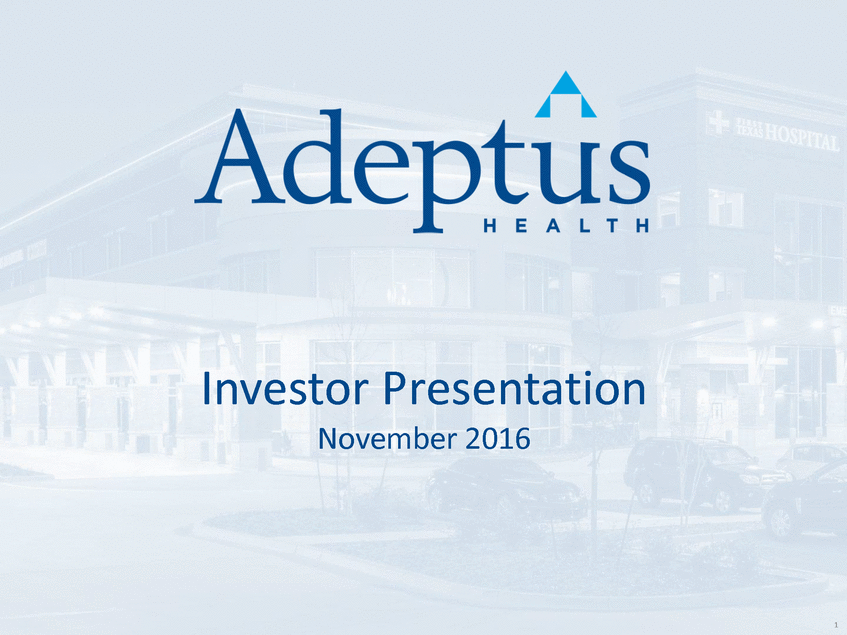
Disclaimer In addition to historical information, this presentation may contain “forward-looking statements” within the meaning of Section 27A of the Securities Act of 1933, as amended (the “Securities Act”), and Section 21E of the Securities Exchange Act of 1934, as amended (the “Exchange Act”), which are subject to the “safe harbor” created by those sections. All statements, other than statements of historical facts included in this presentation, including statements concerning our plans, objectives, goals, beliefs, business strategies, future events, business conditions, our results of operations, financial position and our business outlook, business trends and other information, may be forward-looking statements. Words such as “estimates,” “expects,” “contemplates,” “will,” “anticipates,” “projects,” “plans,” “intends,” “believes,” “forecasts,” “may,” “should” and variations of such words or similar expressions are intended to identify forward-looking statements. Such forward-looking statements are subject to various risks and uncertainties, including our ability to implement our growth strategy; our ability to satisfy the additional conditions to funding with respect to the remaining $10 million of the incremental $25 million of committed term loan financing after the first $15 million have been drawn; our ability to secure sufficient liquidity from external financing sources and maintain sufficient levels of cash flow to meet growth expectations; delays in conversion of accounts receivable into cash, as well as increased potential for bad debt expense, associated with deficiencies in billing and collections related to our services; our ability to protect our brand; federal and state laws and regulations relating to our facilities, which could lead to the incurrence of significant penalties by us or require us to make significant changes to our operations; our ability to locate available facility sites on terms acceptable to us; competition from hospitals, clinics and other emergency care providers; our dependence on payments from third-party payors; our ability to source and procure new products and equipment to meet patient preferences; our reliance on Medical Properties Trust (“MPT”) and the MPT Master Funding and Development Agreements; disruptions in the global financial markets leading to difficulty in borrowing sufficient amounts of capital to finance the carrying costs of inventory to pay for capital expenditures and operating costs; our ability or the ability of our healthcare system partners to negotiate favorable contracts or renew existing contracts with third-party payors on favorable terms; significant changes in our payor mix or case mix resulting from fluctuations in the types of cases treated at our facilities; significant changes in the rules, regulations and systems governing Medicare and Medicaid reimbursements; material changes in IRS revenue rulings, case law or the interpretation of such rulings; shortages of, or quality control issues with, emergency care-related products, equipment and medical supplies that could result in a disruption of our operations; the intense competition we face for patients, physician use of our facilities, strategic relationships and commercial payor contracts; the fact that we are subject to significant malpractice and related legal claims; the growth of patient receivables or the deterioration in the ability to collect on those accounts; the impact on us of PPACA, which represents a significant change to the healthcare industry; and ensuring our continued compliance with HIPAA, which could require us to expend significant resources and capital; and the factors discussed in the section entitled “Risk Factors” in the Company’s Annual Report on Form10-K filed with the SEC on February 27, 2016, as such factors may be updated from time to time in our periodic filings with the SEC, which are accessible on the SEC’s website at www.sec.gov.These factors should not be construed as exhaustive and should be read in conjunction with the other cautionary statements that are included in this presentation and in our filings with the SEC. We undertake no obligation to publicly update or review any forward-looking statement, whether as a result of new information, future developments or otherwise, except as required by law. This presentation contains presentations of non-GAAP financial measures, including Adjusted EBITDA, which is defined as net income before interest, taxes, depreciation and amortization, further adjusted to eliminate the impact of certain additional items, including advisory services paid to a significant shareholder, facility preopening expenses, management recruiting expenses, stock compensation expense, costs associated with our public offerings and other non-recurring costs. For a reconciliation of Adjusted EBITDA to the most comparable GAAP measure, please refer to the Annex of this presentation and to our most recent report on Form 10-Q filed with the SEC in connection with our results for the period ended March 31, 2016 and report on Form 10-K filed with the SEC in connection with our results for the period ended December 31, 2015.See the “Investors” section at www.adhc.com. 2

Presenters Gregory W. Scott Chairman of the Board and Interim Chief Executive Officer Frank Williams Chief Financial Officer Graham Cherrington President and Chief Operating Officer Chris Fleming Director, Financial Planning and Analysis 3
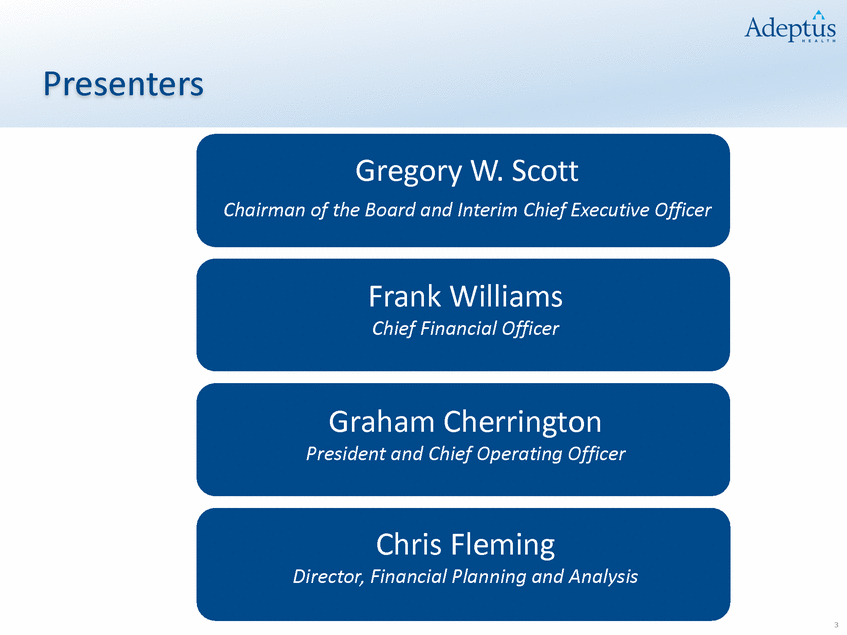
Agenda I. II. III. IV. V. VI. Executive Summary Company Overview Key Credit Highlights Key Operational Initiatives Financial Overview Appendix 4
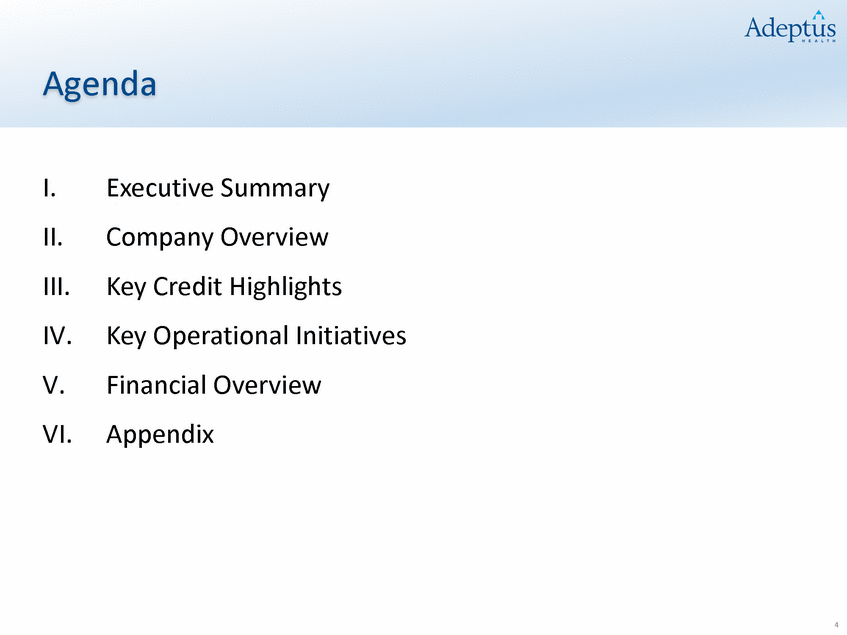
Executive Summary 5
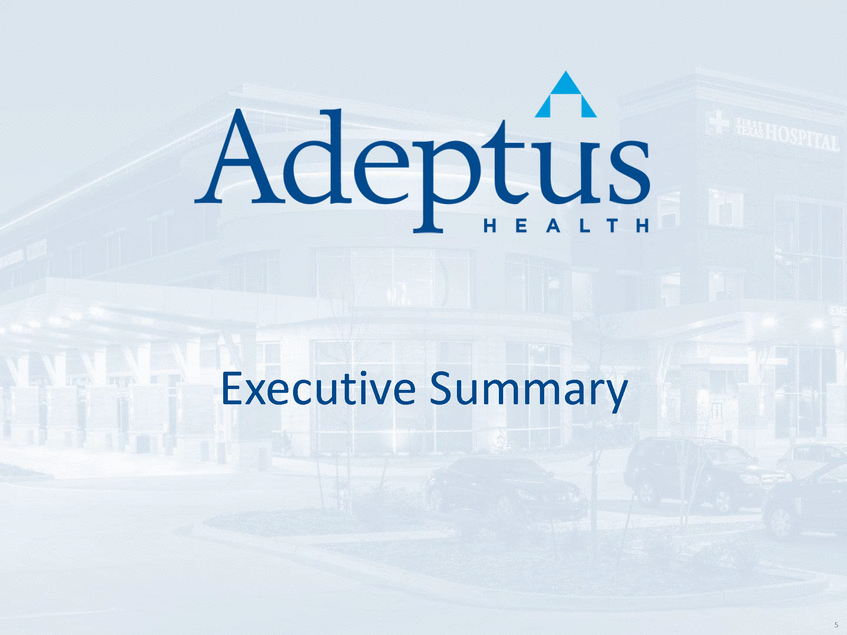
Executive Summary • Adeptus Health Inc. (NYSE: ADPT) provides emergency medical care through the largest network of independent freestanding emergency rooms (“FSERs”) in the United States and has joint ventures and partner services agreements with leading healthcare systems • As of November 1, 2016, Adeptus had 105 facilities in 4 states, including 101 FSERs and 4 hospitals • Although the Company has shown impressive growth since IPO in 2014, Adeptus has recently faced pressure on its liquidity, which has led to a net cash usage of ~$99mm over the last four quarters(1). The liquidity challenges have been driven by several factors: • • • Revenue Cycle Management Working Capital Support for JV Entities Q3 Utilization and Patient Volumes • Although the overlay of these issues has resulted in weak free cash flow generation in the Company’s most recent quarter, Adeptus is well-positioned for future growth and a return to operating normalcy over the next year • The Company has engaged Goldman Sachs to explore various financing alternatives to assist in the effort to achieve, subject to market conditions, a comprehensive refinancing that provides Adeptus with additional financial flexibility • Pro Forma for the recently announced preferred equity issuance and credit facility upsize, the Company’s Total Leverage will be 2.4x and its Rent Adjusted Leverage will be 3.2x, with $64 million of available liquidity(2) Please see page 30 for additional detail. Please see page 41 for additional detail. (1) (2) 6
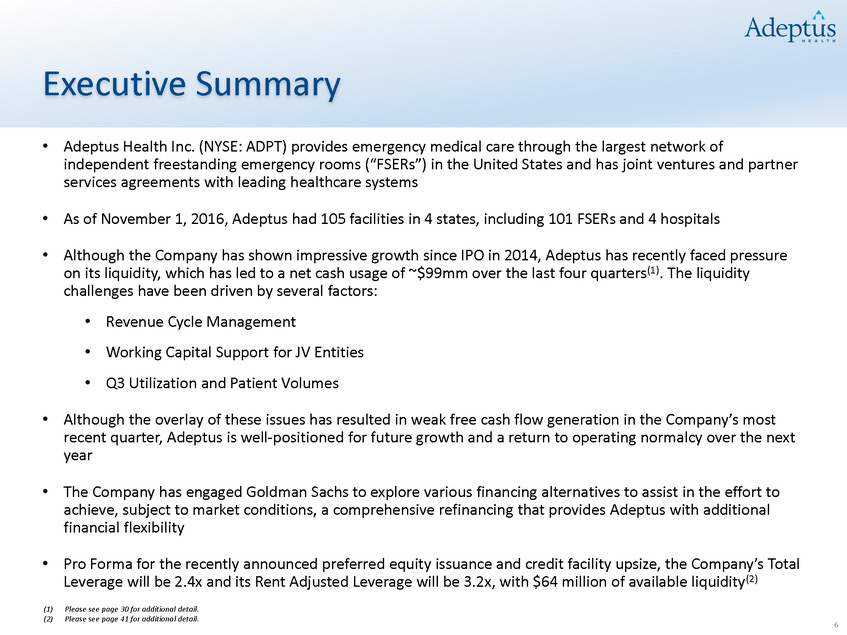
Operational Challenges and Adeptus’ Response 1 ~$103mm Use of Cash in LTM 9/30/2016 2 3 7 Q3 Underperformance • Softer Q3 performance was not unique to Adeptus • Non-HOPD markets drove most of the Q3 year-over-year declines, but by year end more than 80% of Adeptus’ facilities are expected to be HOPD • Positive October volume data, particularly in newly HOPD markets JV Working Capital ~$54mm Use of Cash in LTM 9/30/2016 • Adeptus is working with JV partners to share the burden of increased working capital • Q3 represented a peak for pre-opening expenses • The new partner services model going forward is less capital-intensive Revenue Cycle Management • Combination of growth in the business as well as receivables management has caused systemwide DSOs to increase from 54 days in Q3 2015 to 102 days in Q3 2016 • Third-party specialists engaged to address underpayment • Adeptus has a history of collecting nearly all of its net revenue
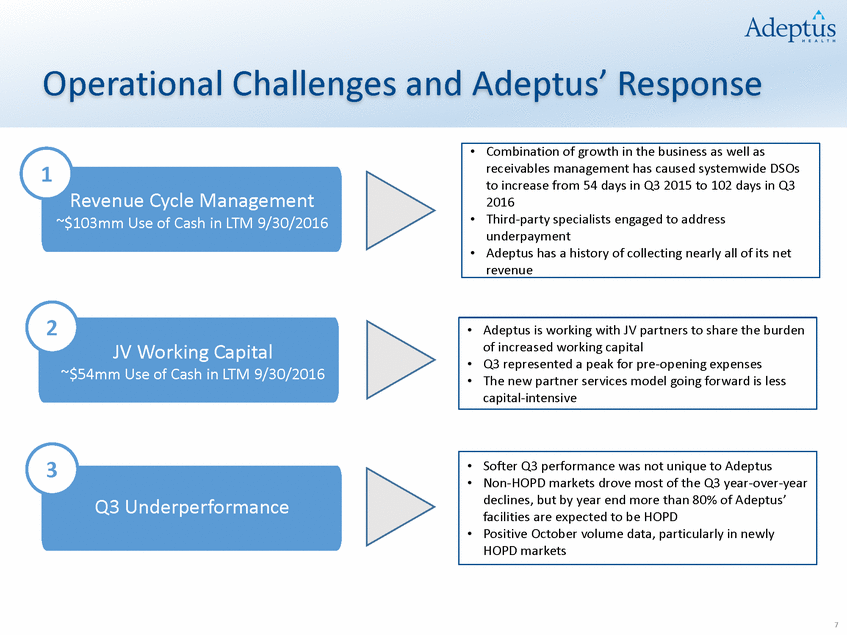
Company Overview 8

Adeptus: Our Mission “Providing access to the highest quality medical care to the communities we serve. In doing so, we are helping to transform the delivery of emergency care in America and, importantly, we are saving lives every day.” 9
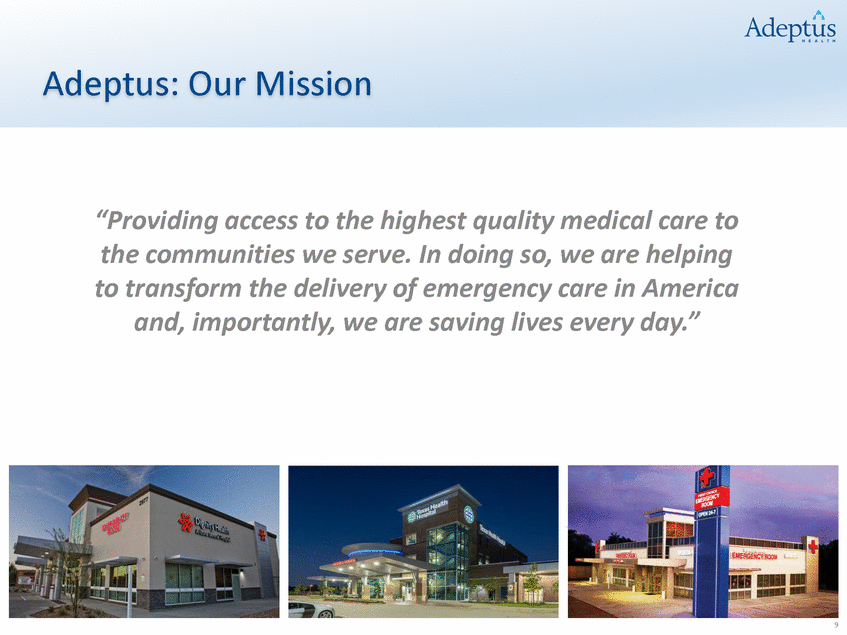
Adeptus at a Glance • Leading operator of freestanding emergency rooms (“FSER”) in attractive markets Founded in 2002 IPO in 2014 105 facilities across 4 states Innovative approach delivers convenient 24-7 access Offers high quality emergency care Enter a JV or partner services model with premier healthcare systems and operate proprietary branded sites 79% of FSERs are Hospital Outpatient Departments (HOPD) — HOPD facilities are able to bill both commercial and government pay patients, whereas non-HOPD facilities can only bill commercial patients Joint Commission accredited as a Healthcare System, with CLIA/COLA certified labs(3) Historical Financials ($ in millions) Unconsolidated Joint • • • • Ventures Revenue $ 553.9 Consolidated Facilities +84% Revenue • • • (1) 2013A 2014A 2015A LTM Adjusted EBITDA(2) Margin % • Facilities Note: Unconsolidated Revenue represents revenue received from facilities that are part of a Joint Venture. (1) LTM as of 30-Sep-2016. (2) Adjusted EBITDA represents net income before interest, taxes, depreciation and amortization, further adjusted to eliminate the impact of certain additional items, including facility preopening expenses, stock compensation expense, costs associated with our public offerings and other non-recurring costs, losses or gains. Please refer to page 50 for an Adjusted EBITDA reconciliation. (3) CLIA stands for Clinical Laboratory Improvement Amendments, which are federal regulatory standards that apply to all clinical laboratory testing. COLA stands for Commission of Office Laboratory Accreditation. 10 $ 16.0$ 28.2$ 75.9$ 75.0 15.5 %13.4 %17.8 %13.5 % 265583105 Revenue CAGR$ 425.3 $ 201.6 $ 210.9$ 0.2 $ 74.8 $ 352.3 $ 350.5 $ 102.9 $ 210.7

Leading Player With Footprint An Expanding Geographic Facility Breakdown Services (1) Facility count as of November 1, 2016. Note: Entered into agreement with Ochsner Health in September 2015; Announced expansion into Ohio with Mount Carmel Health in February 2016. 11 MarketsFSERsHospitals JVsPartner Dallas / Ft. Worth321 Houston301 Austin6-San Antonio7-Texas732 Denver141 Colorado Springs4-Colorado181 Arizona91 Louisiana1-Ohio--Total(1) 1014
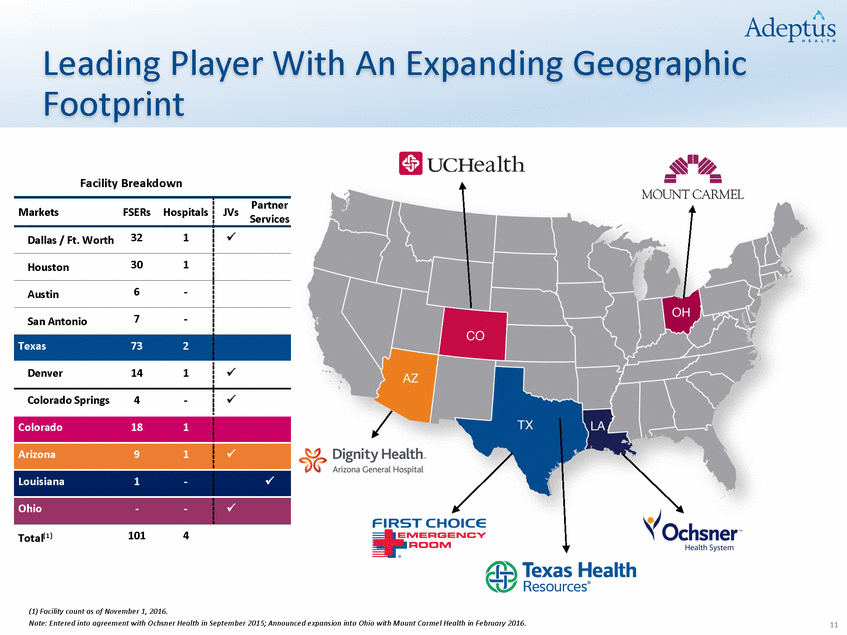
Adeptus is Helping Address the National Crises for Access to Emergency Medical Care • Declining supply of emergency departments while demand for emergency care is rising Crowded ERs the longer the wait the worse the outcome can be Currently there are ~500 freestanding ERs in the U.S. Representing a significant opportunity to deliver quality care in the freestanding emergency room setting and transform this underpenetrated market “Emergency and wait are two words that shouldn’t go together—it’s oxymoronic” • • • -Dr. Jay Kaplan President of the ACEP Modern Healthcare February 15, 2016 Source: Wall Street Journal Note: ACEP stands for American College of Emergency Physicians. 12
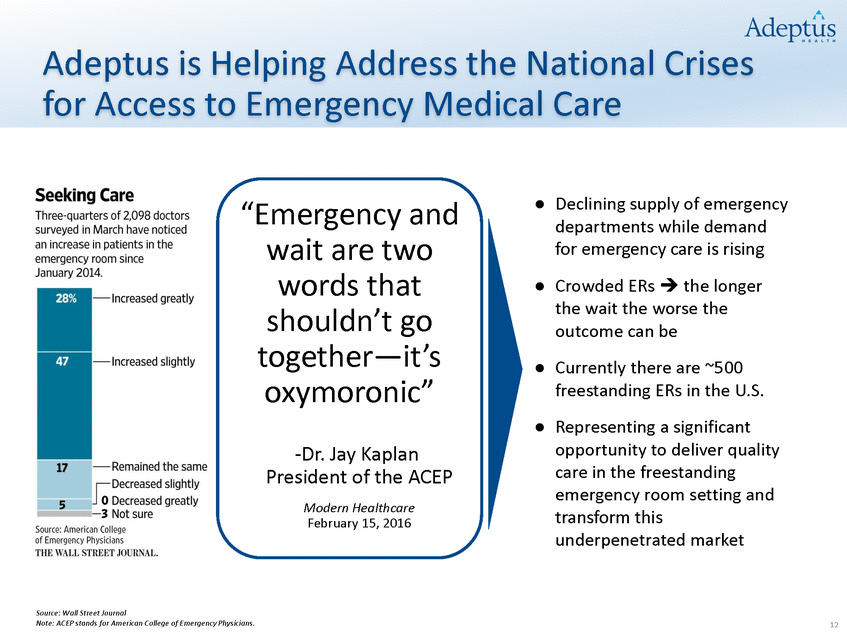
Adeptus is Addressing an Unmet Need Low Acuity / Primary Care High Acuity / Emergency Care CEP Acuity Levels 1 and nursing staff, 13 A 2 ACEP Acuity Lev els 3, 4 and 5 Retail Clinics Urgent Care Physician Office Freestanding ER Hospital ER Driving Forces • Real – time after hours• Cost effective alternative • Traditional “medical access to basic carefor lower-acuity carehomes” for consumers • Convenient access to critical, high acuity care • Traditional emergency care destination Care Provided • Time sensitive common• Time sensitive low acuity • Preventative & family cold carecarecare • Emergency care for high acuity patients • Emergency care for high acuity patients Staffing • Nurse practitioners,• Physicians / physician• Primary care physicians physician assistantsassistants, nursing staff • Board certified / board eligible physicians, nursing staff, technologists • Board certified / board eligible physicians, technologists Equipment • Basic diagnostic• Diagnostic equipment• Basic diagnostic equipmentincluding Phlebotomyequipment and x-ray • Diagnostic equipment including x-ray, CT scanner, on-site CLIA / COLA laboratory, ultrasound • Full suite of diagnostics and lab equipment Key Attributes • Shorter wait time• Shorter wait time• Limited on-site diagnostic capabilities • Limited critical care treatment • Shorter wait time • 24/7 access • Rapid diagnostics results • Direct admission to hospitals if needed • 24/7 access • Direct admission to hospitals if needed ~93% of Adeptus patients have American College of Emergency Physicians (ACEP) acuity level >3 with an average ACEP acuity level of 3.6
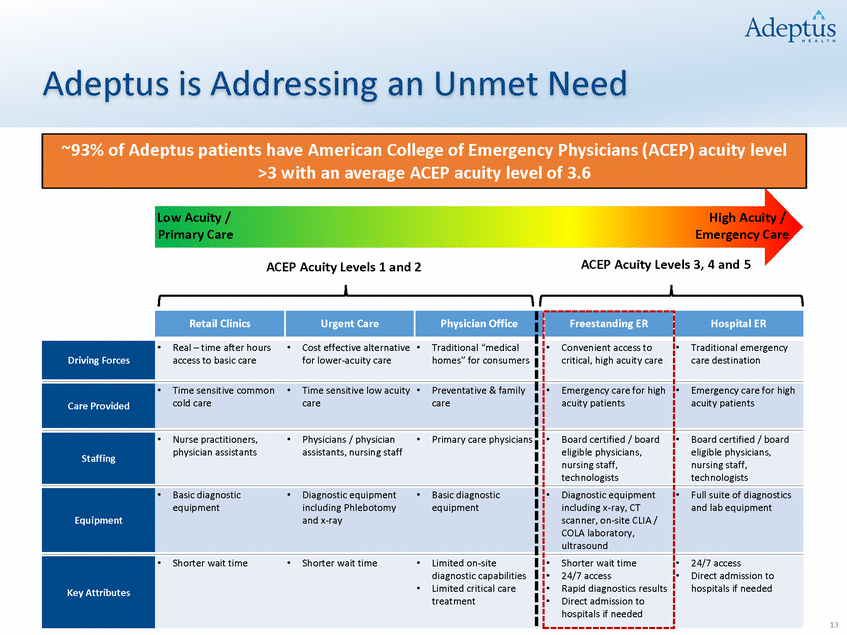
Innovative Facility Model Open 24 / 7 with short wait times Typically 6 to 9 exam rooms Includes 2 high-acuity and one “child friendly” pediatric room CLIA / COLA certified labs: all test results within approximately 20 minutes “1-1-1-1” staffing model: doctor, nurse, technologist and front office staff at all times Full radiology suites including CT scanners, digital x-rays and ultrasounds PATIENT ENTRY AMBULANCE EXIT 14
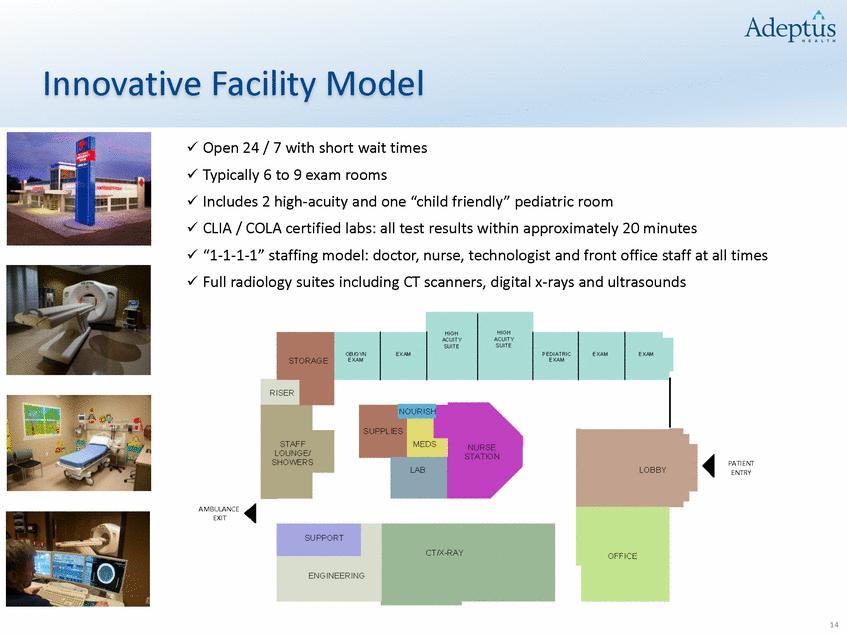
Adeptus Offers a Benefit for All Constituents Patients Hospitals Payors Moves the point of access for care closer to the patient Reduced wait times (Average wait time < 5 minutes) Convenient 24/7 access to high-quality emergency care with long-tenured board-certified physicians Expands hospital reach, giving them access to a larger, more spread-out patient population Enhances coordination of follow-up care throughout the health system Relieves pressure on the hospital ER Higher quality care, with reduced wait times yields better outcomes Greater capacity leads to fewer outpatient to inpatient transfers and potentially lower cost of care per patient Providing the highest level of care, close to home for our patients, is one of UCHealth’s priorities…Partnering with Adeptus Health allows patients to receive care in a more convenient way, while also offering seamless transfers to hospitals for patients who need hospitalization We want to offer a full spectrum of care and see patients when and where they want to be seen. This partnership is truly an extension of that effort and is expected to ensure many Louisiana residents will no longer have to drive more than 30 minutes when they need critical, emergency care services - Warner Thomas President and CEO of Ochsner - Elizabeth Concordia President and CEO, UCHealth 15
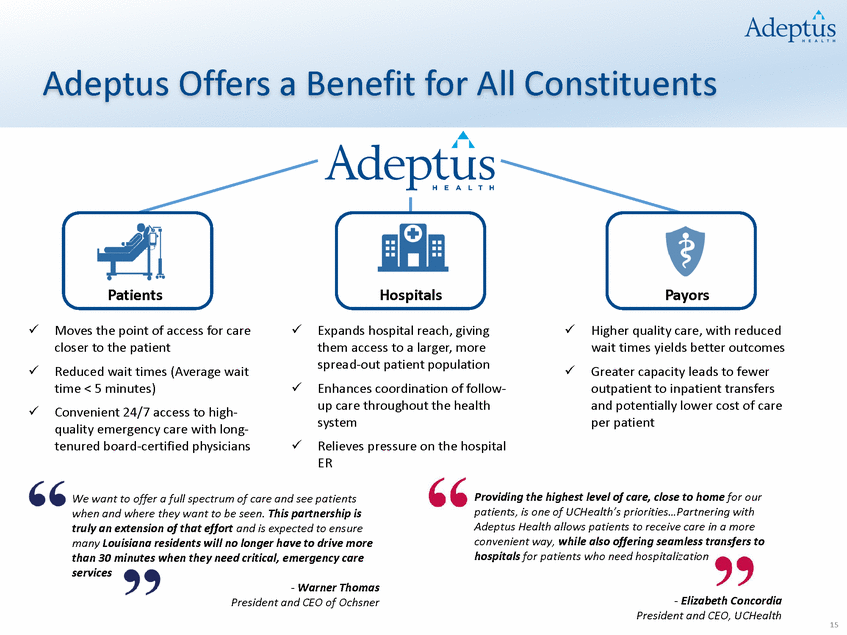
Customer Testimonial https://www.youtube.com/watch?v=xEKWhFJfaec 16
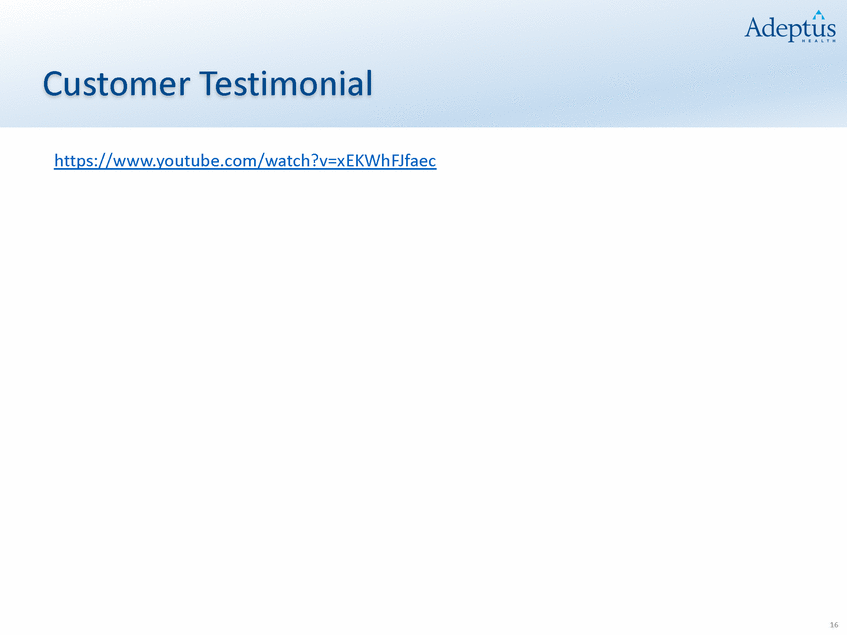
Common Questions Question Response What is the cost of a FSER compared to an acute care hospital ER? Are you treating patients who should instead be seen at an urgent care facility? Are you in-network or out-of-network? 17 • In JVs and the partner services model, FSERs that have HOPD status operate under the same in-network agreements as their hub hospital • In non-partnered facilities, FSER billing is processed directly or through a secondary network relationship (e.g. MultiPlan) • The American College of Emergency Physicians establishes a scale of acuity, where cases rated 3-5 should be seen in an emergency setting — ~93% of our patients have an acuity level of 3 or greater • The cost of a FSER is generally equivalent to an acute care hospital ER given the level of care is comparable • In a joint venture, the FSERs bill under the parent hospital’s provider number
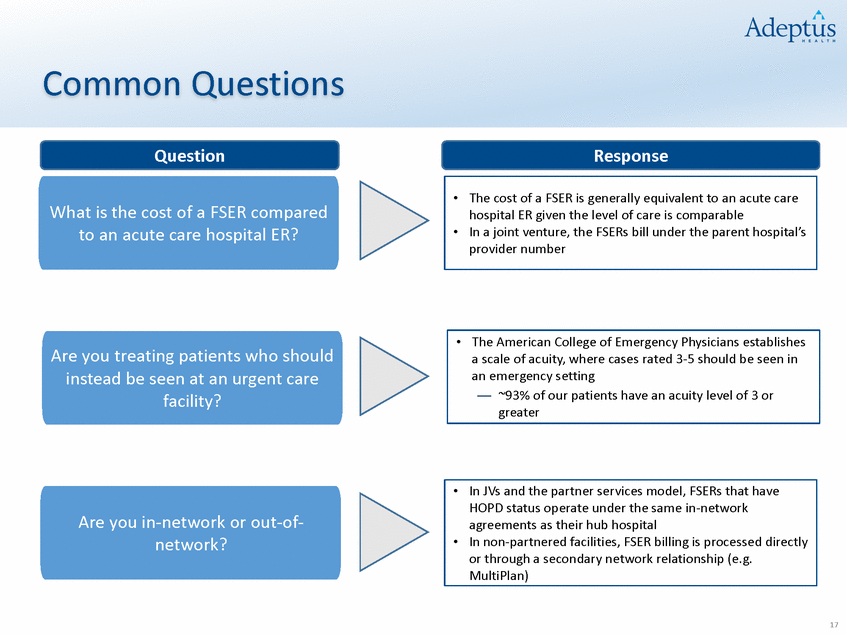
Key Credit Highlights 18

Key Credit Highlights 1 Leader in the Expanding Freestanding Emergency Room Market 19 5Dedicated Management Team With Renewed Investor Support 4Favorable Facility Economics 3Hospital JVs and Partner Services Model Provide Stability to the Business 2Innovative Model That Delivers High-Quality Care and Benefits All Constituents
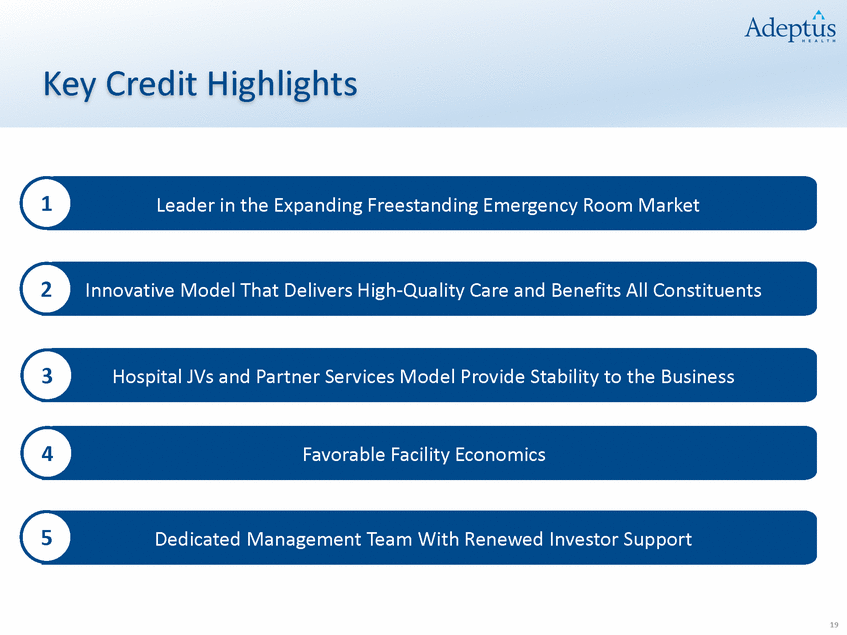
ER Demand is Significantly Outstripping Supply 1 Significant Supply and Demand Imbalance (Visits in millions)(1) Hospital Emergency Departments Emergency Department Visits 5,100 5,000 4,900 4,800 4,700 4,600 4,500 4,400 4,300 4,200 4,100 160 Decrease in hospital EDs 140 120 Increase in ED visits 100 80 60 40 20 0 1993 1994 1995 1996 1997 1998 1999 2000 2001 2002 2003 2004 2005 2006 2007 2008 2009 2010 2011 2012 2013 2014 ACEP 2014 National Report Card Source: American College of Emergency Physicians (1) Source: American Hospital Association Annual Survey data, 2014. 20 Access to Emergency Care D-Overall D+
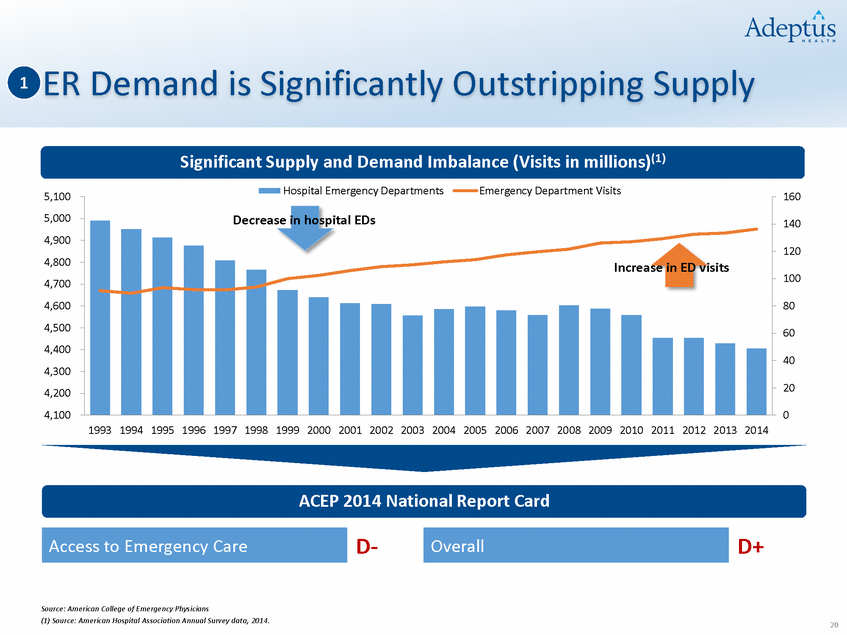
Adeptus Improves the Quality of Care to the 2 Patient and Benefits All Constituents Expanded Catchment Area Adeptus FSER: Moves the point of access for care closer to the patient Offers convenient 24/7 access to emergency care Hospital Catchment Area Expands the reach of hospitals Relieves pressure on acute care hospital ERs Potential to lower cost of care to payors with higher quality, lower wait times and fewer hospital admissions, improving the efficiency of the health system = FSERs Legend: 21 Adeptus’ Freestanding ER’s Expand the Reach of Hospitals Beyond Their Initial Catchment Areas
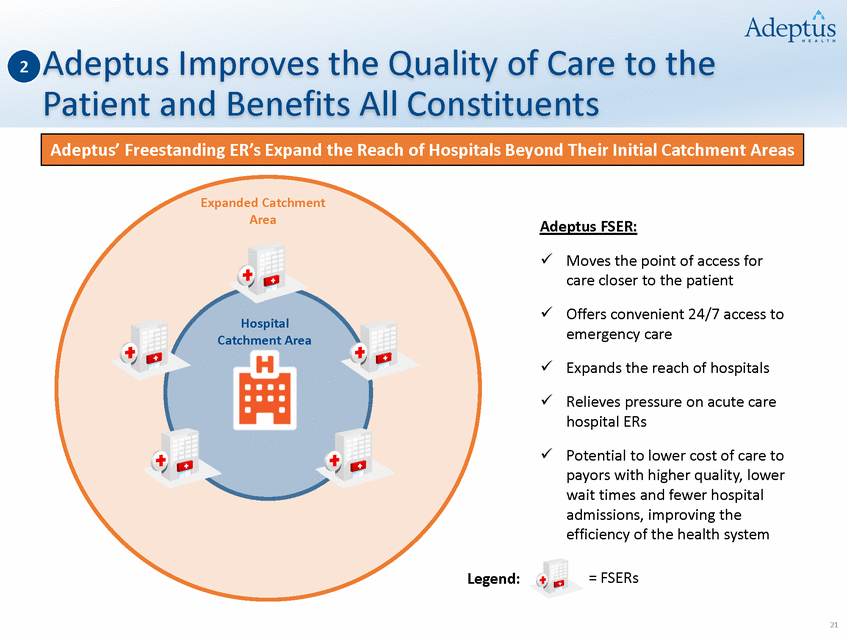
Adeptus’ Value Proposition to Its Partners 2 • Adeptus expands an existing health system’s network such that patients living further from the hospital can get access to care: The partner receives a portion of earnings associated with patients that it otherwise could not service efficiently Patients needing follow-up care can be referred into the partner’s health system, improving the coordination of care throughout the system Patients facing the most severe conditions can be transferred into the partner’s broader network immediately 22
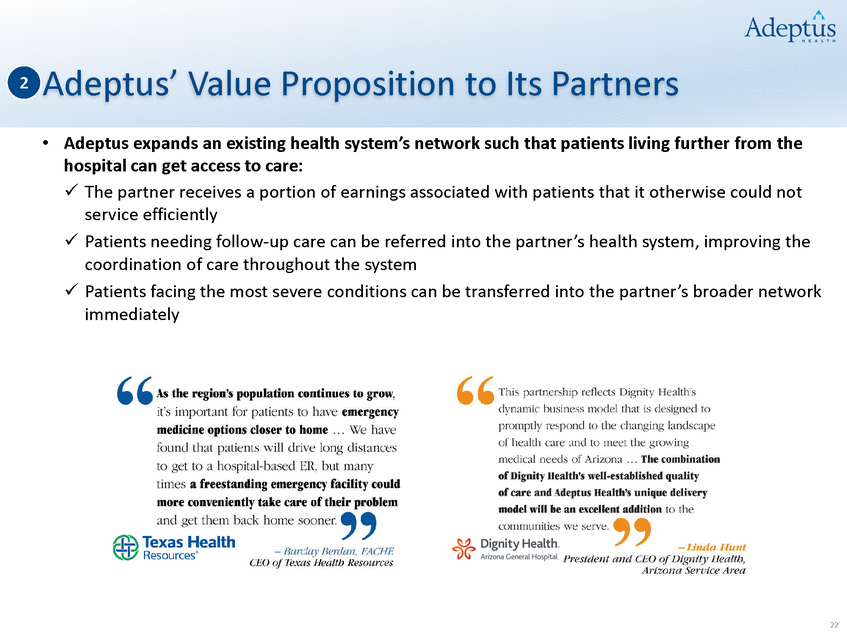
The Adeptus Business Model has Evolved Over Time… 3 2013 2014 2015 2016 • Adeptus’ patients gain direct access to HCA’s ~5,500 physicians and 12 hospitals in North Texas and ~3,300 physicians and 9 hospitals in the Houston area. Alliance with Concentra in the Dallas / Ft. Worth market • Expansion into Arizona through a joint venture with Dignity Health. The JV now operates Dignity Health Arizona General Hospital, a full service hospital along with HOPDs. The JV is in the process of building another hospital and additional HOPDs • JV with UCHealth in Colorado, UCHealth obtained a majority stake in 12 FSERs that were operational at that time The joint venture now includes two hospitals. The hospitals are in the process of converting the FSERs to HOPDs Entered into JV with Ochsner Health System in Louisiana, which has now been transitioned to the partner services model. Ochsner opened the first HOPD under the partner services model in October 2016 • JV with Texas Health Resources in Dallas / Ft. Worth The joint venture includes Texas Health Hospital and 32 HOPDs Entered into a joint venture agreement with Mount Carmel Health System in Ohio • • • • • • Introduction of hub and spoke model allows FSERs to become HOPDs 23 As the Company expands into new markets, particularly in states with complex regulatory requirements, Adeptus has developed and utilizes models in association with joint ventures and the innovative partner services model
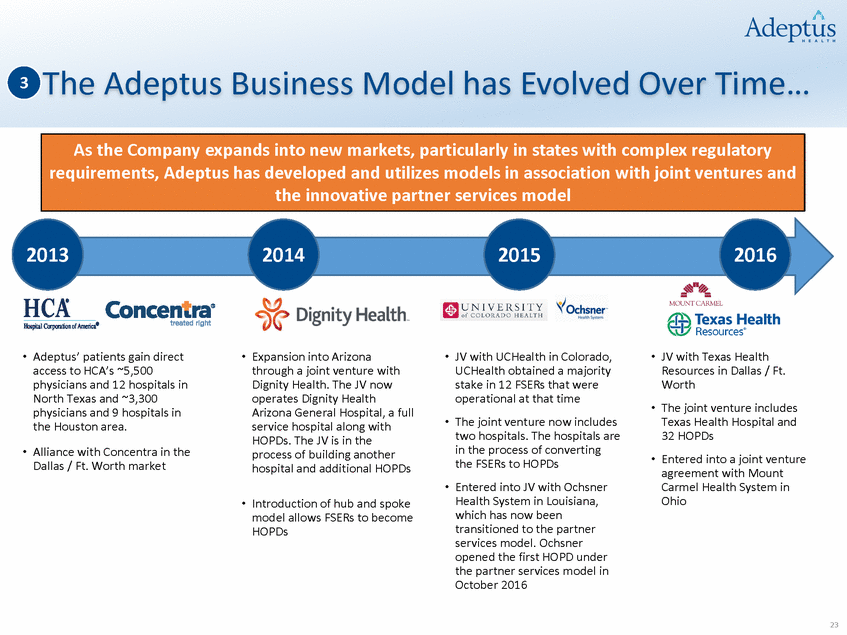
…Which Allows Adeptus to Capitalize on Growth Opportunities 3 Freestanding Emergency Rooms (FSERs) Hospital Hub / Satellite Model (HOPD) - Independent Joint Venture Partner Services Dallas / Ft. Worth (Texas Health Resources) , Arizona (Dignity Health), and Colorado (UC Health) San Antonio and Austin Houston Louisiana (Ochsner) • Company enters into a partner services agreement with leading hospital brands to develop and manage FSERs that will have HOPD status Company manages the HOPDs in accordance with provider based billing regulations Company receives a network development fee and a management fee • Company operates FSERs on a standalone basis Facilities only bill commercial payors and private pay patients New facilities are funded via 3rd party developer and leased back to the Company • Hub and spoke model where hospitals serve as an umbrella under which FSERs can obtain HOPD status Facilities bill government, commercial payors and private pay patients • Company enters into a joint venture agreement with leading hospital brands and develops and manages hospitals and FSERs that will have HOPD status Company splits profits with joint venture partner based on equity ownership percentages All fees are supported by an FMV report from a third party appraiser • • • • • • • • • • • • Expanded suite of service offerings Access to new markets Access to direct payor contracts Access to new markets Brand recognition Similar economics as JV structure without the working capital requirements • Joint Quality Assurance programs Reimbursement from commercial payors • • 24 Government Reimbursement Key Benefits Approach Examples
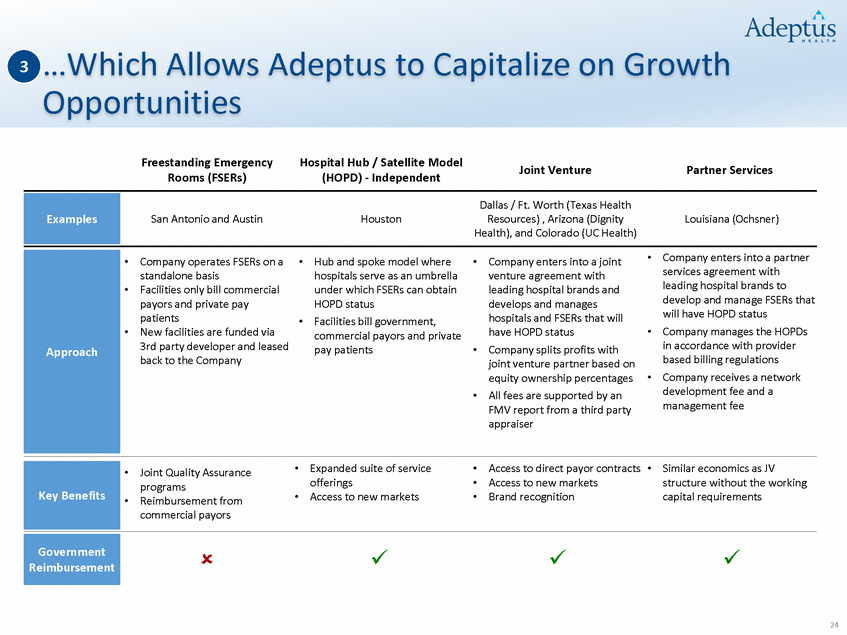
Freestanding ERs Achieve Profitability Arizona (HOPD) Rapid Ramp to 4 HOPD Unit Economics Typical facility reaches full run rate in 12-15 months • Indexed Net Revenue Indexed Facility EBITDA — Cost $250k in preopening expenses, with all construction costs financed by third party developer from whom the Company leases the facilities 1.9 x 1.9 x 1.8 x 1.6 x 1.6 x 1.5 x 1.5 x 1.4 x 1.4 x 1.0 x 1.4 x 1.4 x 1.2 x 1.2 x 1.2 x 1.0 x 1.1 x 1.0 x 0.8 x 0.7 x — Generate ~$5-6 million of systemwide net revenue annually 0.7 x 0.6 x 0.6 x 0.6 x 0.6 x 0.5 x 0.5 x 0.4 x 0.4 x 0.4 x 0.3 x 0.4 x — Generate ~$1-2 million of facility EBITDA resulting in margins ranging from 28% to 33% Patient Volume • Payback initial investment of ~$250k in less than two months of operation Note: Figures above have been indexed to month 1 25 Month 1 Month 2 Month 3 Month 4 Month 5 Month 6 Month 7 Month 8 Month 9 Month 10 Month 11 Month 12 Month 13 Month 14 Month 15 Month 16 Arizona facility represents a case study of a partnered HOPD facility 562 721 713 749 777 787 859 843 805 995 909 804 736 628 640 697 • By the second month, the Arizona facility generated 1.4x the revenue it generated in the first month • Facility was profitable from the first month
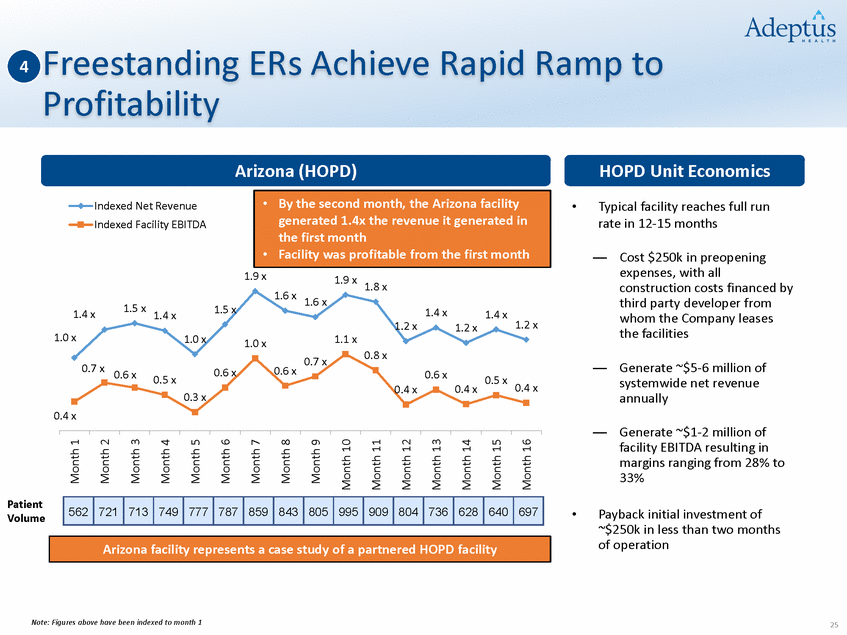
HOPD Conversion in DFW Represents a Successful 4 Case Study for Business Model Step 1: Transition from Non-HOPD to HOPD Transition Step 2: Transition to JV Same-Store Sales • Began as a Non-HOPD market with only standalone FSERs • On November 4, 2015, opened a full-service hospital facility to serve as a hub for the 25 FSERs in DFW at the time • Experienced rapid growth in patient volumes and revenue upon conversion of existing FSER facilities to HOPD facilities • On May 10, 2016, announced partnership with Texas Health Resources (THR) in the Dallas-Fort Worth area (in $ millions) +15% YoY Growth $ 33.3 • Texas Health Resources is one of the country’s largest non-profit health systems Q3 2015 Same-Store Volume Growth Q3 2016 Facility EBITDA(1) • In early September 2016, rebranded all DFW First Choice Emergency Rooms and the First Texas Hospital Carrollton (renamed Texas Health Hospital) as THR facilities 25,052 +56% YoY +122% YoY $ 12.0 Q3 2015 Q3 2016 Q3 2015 Q3 2016 Note: Same –Store analysis only includes facilities at least 16 months into opening (1) Facility EBITDA includes the effect of preopening expenses and hospital losses as well as management fees associated with the Texas Health Resources JV. 26 Transition to JV Expected to Further Drive Volume Transition to HOPD drives increased patient volume, revenue and EBITDA Growth $ 5.4 Growth 16,085 $ 28.9
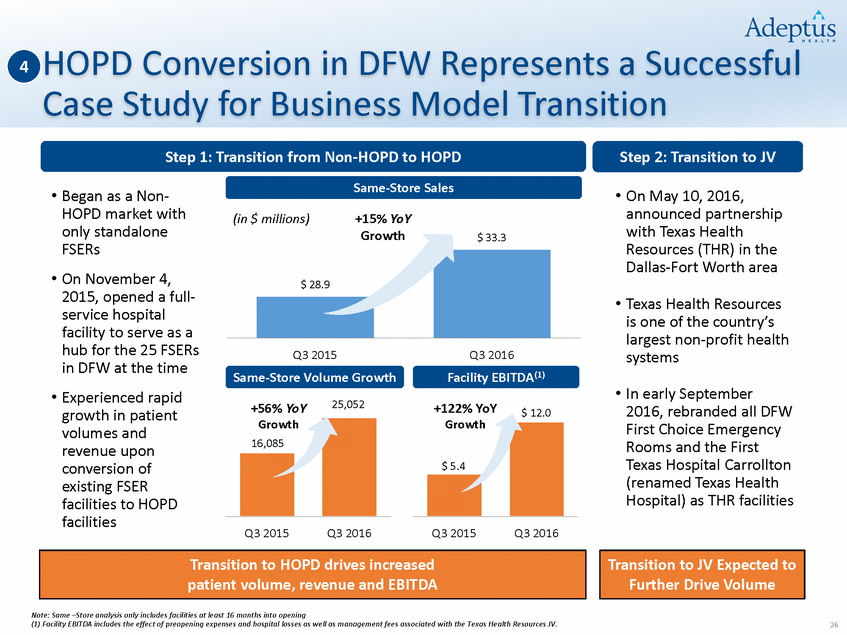
Dedicated Management Investor Support Team with Renewed 5 Gregory W. Scott Chairman of the Board and Interim Chief Executive Officer Recent Developments • On November 1, 2016 appointed Gregory W. Scott as Chairman to replace Thomas Hall who announced his retirement in September 2016 • 25+ years of experience in healthcare services • Appointed Frank Williams as CFO in July of 2016 to replace outgoing CFO Timothy Fielding Frank Williams Chief Financial Officer 23+ years of finance and healthcare experience • • Received $27.5mm preferred equity investment in October 2016 from several co-founders as well as Sterling Partners illustrating strong private support Graham B. Cherrington President and Chief Operating Officer • 15+ years of healthcare operations experience • On November 7, 2016, appointed Gregory W. Scott as Interim CEO 27 Adeptus has Made Recent Changes to its Management Team in Order to Position the Company for Future Growth
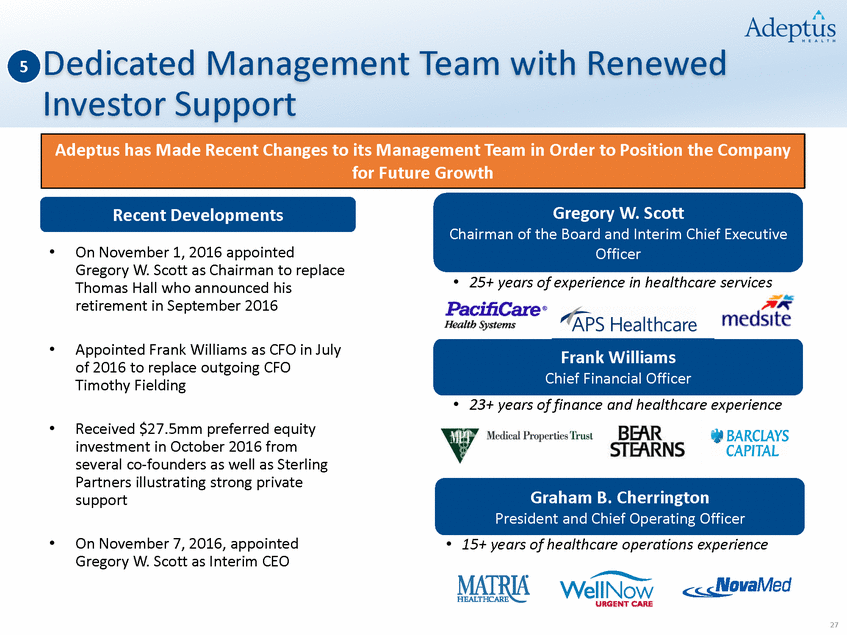
Key Operational Initiatives 28
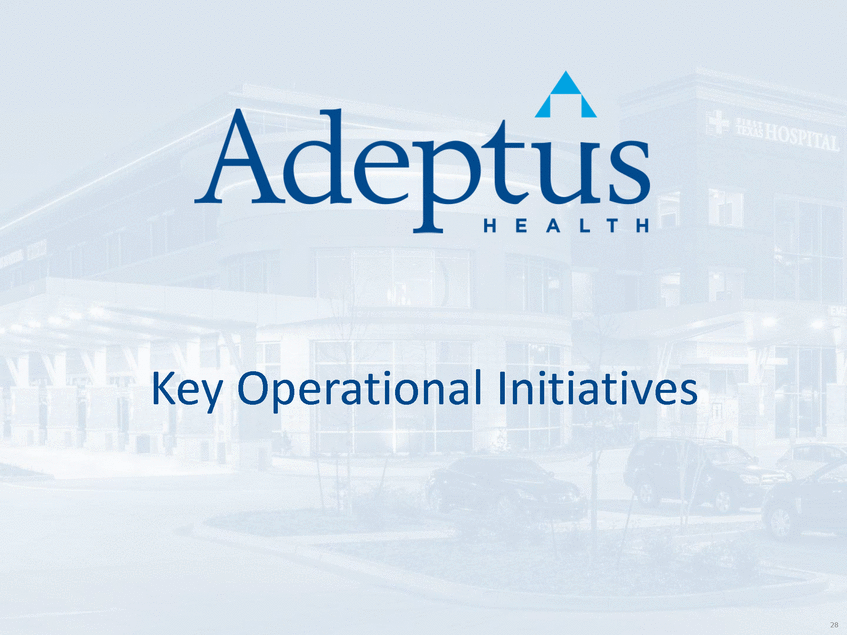
Key Operational Initiatives 1 2 3 29 Q3 Utilization and Patient Volumes Working Capital Support for JV Entities Revenue Cycle Management
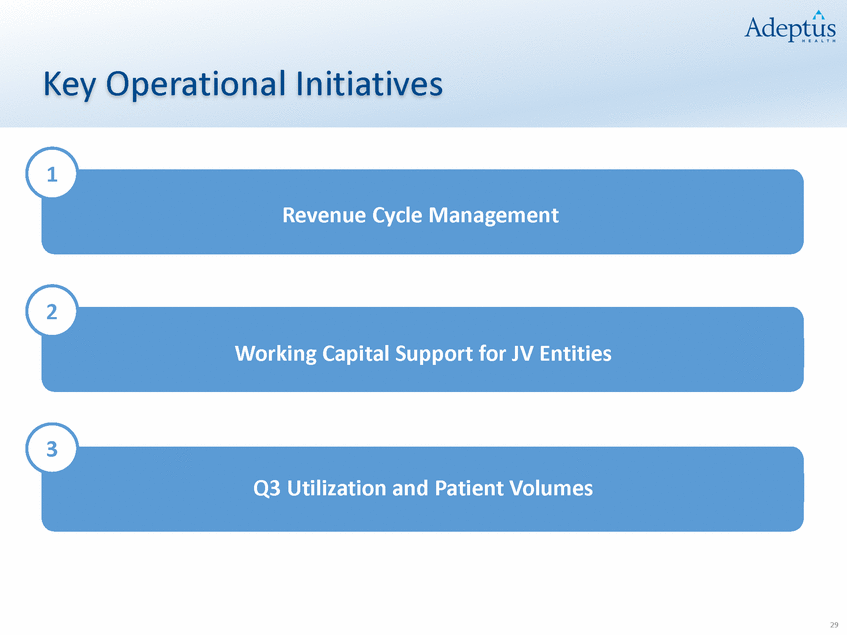
Liquidity Challenges • Adeptus’ liquidity shortfall has been driven by three key factors: (1) revenue cycle management issues (2) continued working capital support for JV entities, (3) lighter than expected 3Q performance The Company has taken proactive measures to address these issues by moving towards more efficient JV structures and engaging a specialist to relieve billing and collection issues • LTM 9/30/2016 Free Cash Flow Bridge $200 $150 $100 $50 $28 $34 $0 ($7) ($50) ($3) ($7) ($100) 3Q15 Cash Balance Adj. EBITDA Accounts JV Preopening Cash Interest Cash Taxes & Other Capex in Other Assets & Liabilities Cash Revolver Borrowings Preferred Equity 3Q16 Pro Forma Cash Balance Receivable Receivables Expenses 30 ~$99mm net cash need during the past 4 quarters $75($103) $46 ($54)$60 ($23) $22

Revenue Cycle Management 1 Revenue Cycle Issues In October 2015, McKesson took over the Company’s billing and collections processes — Pre-McKesson, the Company had an internal billing and collections team that actively followed up with payors to ensure appropriate and timely reimbursement — The decision to outsource was driven by the need to ensure compliance with regulatory ICD-10 medical coding requirements Since McKesson assumed billing and collections roles, systemwide DSOs have spiked from 54 days in Q3 2015 to 102 days in Q3 2016(1) Peer DSO Comparables Solutions Adeptus has engaged third-party specialists to actively review claims data and resolve claims on a micro level • • — Billing and collections process for FSERs is high-touch, but McKesson’s methods are automated and low-touch One of these specialists has worked with the Company in the past on the manual process of collecting bad debt expense from individual patients and is familiar with Adeptus and its business model — • • The third-party specialists improve Adeptus’ ability to receive the appropriate level of reimbursement from commercial payors — Third-party specialists are compensated based on amount of receivables recovered in commercial claim appeals Specialists are already working with payors and initial feedback is positive 110 102 100 90 — 80 70 • The growth of Adeptus’ joint venture and partner services models should reduce billing disputes 60 52 49 43 50 — In the JV and partner services models, Adeptus’ FSERs bill under the parent hospital’s provider number 40 30 Mar-14 Sep-14 Adeptus (1) Mar-15 Sep-15 Mar-16 Sep-16 Ambulatory Surgery Center A Hospital A Ambulatory Surgery Center B (1) Calculated based off of systemwide revenues and systemwide receivables. 31 DSO (days) 65
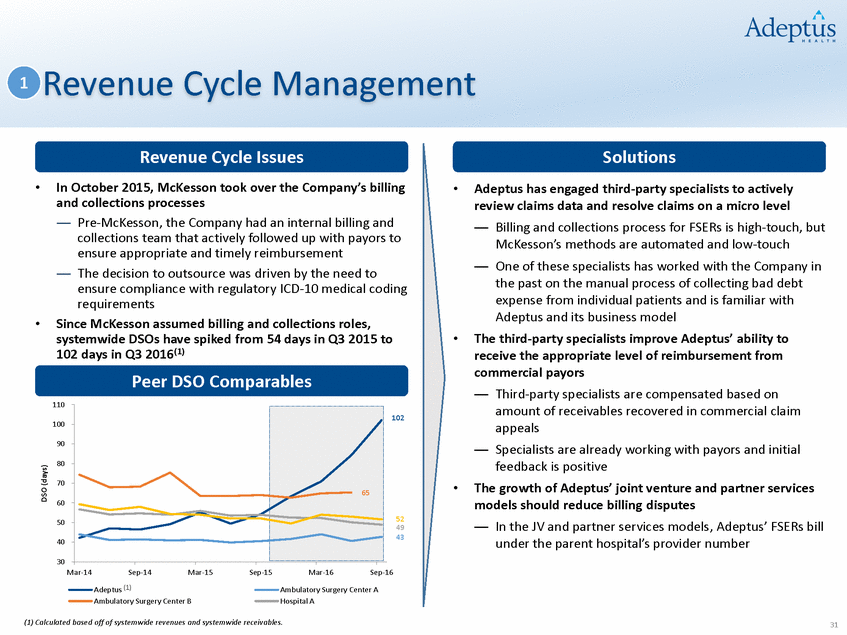
Revenue Cycle Collections Management: Historical Cash 1 Historical Cash Collections 90.0% ) 84.2% Collections in Q4 2015 80.0% 73.9% 73.5% Collections in Q2 2016 71.8% 68.6% 70.0% 60.0% 50.0% 40.0% 30.0% 20.0% 10.0% 3.5% 2.8% 2.4% 1.2% 0.0% < 90 days 90 < x < 180 Days 180 < x < 270 Days x > 270 Days Time Elapsed After Visit Date Note: For periods in which data is not yet available, cash collections as a percentage of booked net revenue average only across the available months. For example, Q3 2016 90-day collections metrics only capture 90 days of collections for July 2016 billings, 60 days of collections for August 2016 billings and 30 days of collections for September 2016 billings. 32 Cash Collections as a % of Booked Net Revenue Pre-McKesson, Adeptus collected ~97% of its receivables within 270 days Collections in Q1-Q3 2015 (pre-McKesson Collections in Q1 2016 Collections in Q3 2016 Average cash c 90 days of service before McKesson — Since eng 2015, aver 68.6% in Despite the age, Ad payments on 9.0% 9.5% 9.1% 9.6% 4.8%
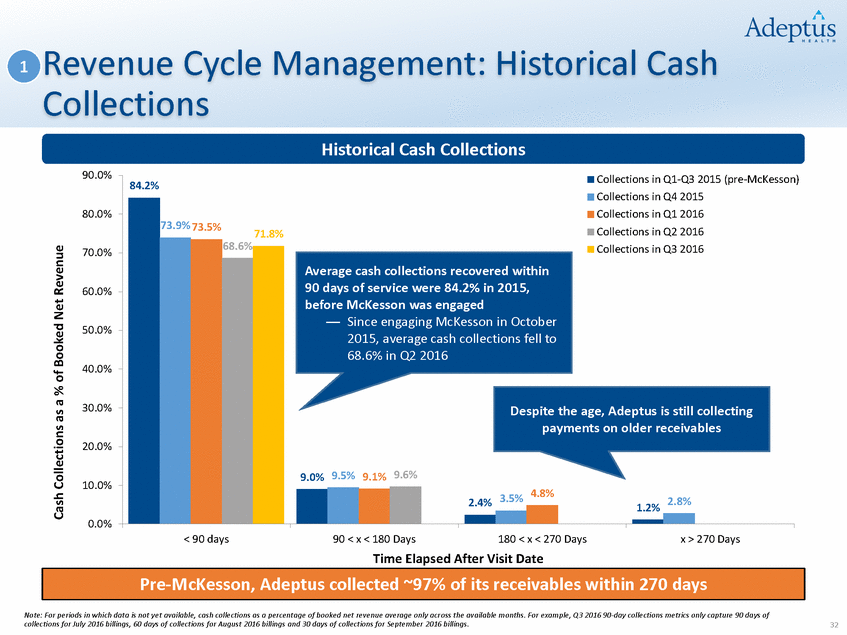
Adeptus’ Current JV Model 2 • Adeptus earns both a management fee and physician staffing fee, as well as a share of the profitability of the JV — In the Dallas and Colorado JVs, Adeptus receives all of the initial JV profitability (the “Preferential Earnings”), until a threshold is reached and any excess earnings or losses are shared with the JV partner based on the ownership stake To date, Adeptus has funded the historical working capital needs of the JV, which has impacted near-term liquidity as those JVs have ramped — Adeptus is positioned first in the waterfall of payments until it is reimbursed for the working capital it has funded • Adeptus Health LLC. Adeptus Legacy Non-JV Operations (100%) Adeptus Health Management Entity (100%) Adeptus JV Participant (~50%) JV Partner (~50%) Earnings JV Entity (1) NMP revenues and / or staffing management fees are National Medical Professionals management and staffing fees, which are payable to Adeptus. NMP Arrangements are in accordance with applicable state corporate practice of medicine guidelines. (2) Preferential Earnings arrangement applies to the UC Health JV in Colorado and the Texas Health Resources JV in Dallas/Fort Worth. 33 Management Fee Share of Upfront Working Capital (Historical) Preferential Earnings(2) + Share of Residual Earnings NMP revenues and / or staffing management fees(1)
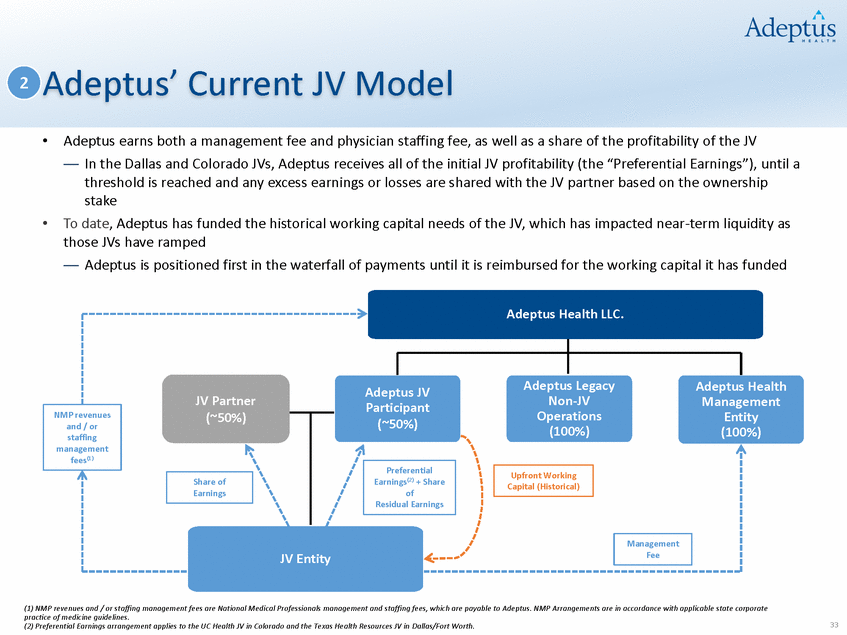
Addressing the JV Working Capital Need 2 JV Benefits Increased traffic, from both commercial and government pay patients (which can be profitable given low marginal cost) —The branding and network associated with partnered health systems enhances Adeptus’ visibility to commercial patients, while the hospital affiliation also enables the Company to accept government reimbursement Expansion of addressable markets, allowing Adeptus to pursue growth in new states (e.g. Ochsner Health System in Louisiana, Mount Carmel Health System in Ohio) Receipt of a management and physician staffing fee and a preferred distribution on the JV stake (in DFW and Colorado), in addition to JV profitability Ability to operate under the JV partners’ managed care contracts and bill at the already contracted rate JV Challenges Adeptus to date has funded 100% of net working capital needs at the JV level, though the Company has limited contractual obligations to do so Working capital usage at the JV entities has been compounded by revenue cycle management issues Solutions Adeptus is exploring a comprehensive refinancing plan that would provide the Company with additional financial flexibility • • • The Company expects to work with JV partners to share the upfront working capital burden — Adeptus has limited contractual obligations to fund JV working capital needs • • The Company’s JV model continues to evolve toward a new, capital-light partner services model • — With the Ochsner Health System (Louisiana) model, through the partner services agreement, Adeptus does not need to incur the capital outlay of building and supporting a new hospital and does not fund the JV’s working capital ramp for new HOPDs • • Adeptus’ engaged third-party specialists are already working with payors, and initial feedback is positive • • 34
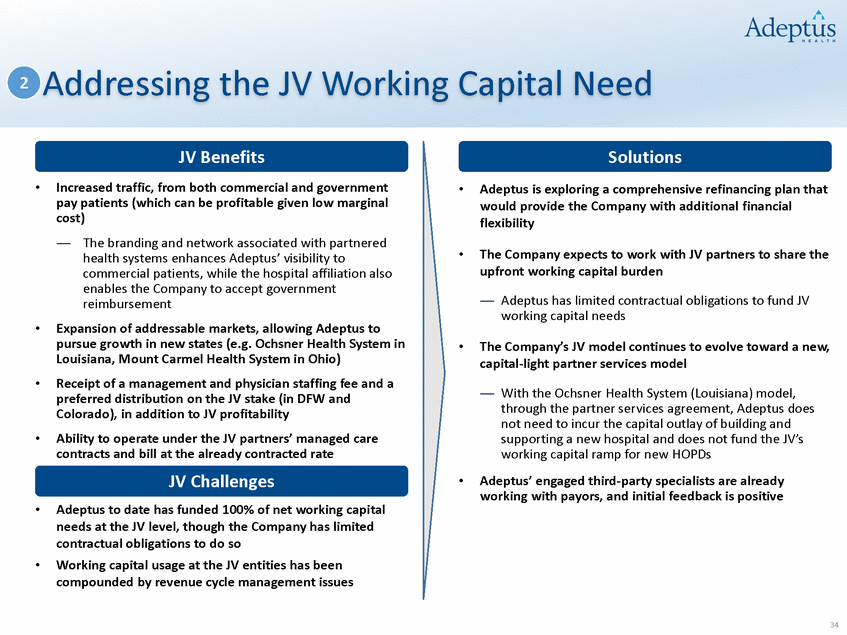
JV Partnerships’ Impact on Other Receivables 2 • To date, Adeptus has funded 100% of net working capital needs at the JV level, although with limited contractual obligations to do so —An Adeptus-funded cash deficit at the JV entity increases Adeptus’ “Other Receivables” balance Significant growth in Adeptus’ JVs, including growth in facilities, has caused the balance of Other Receivables to increase (notably, the opening of the Denver and Colorado Springs hospitals associated with the existing UC Health JV in 2H 2016) —Additionally, entrance into the Texas Health Resources JV (Q2 2016) has resulted in higher Other Receivables due to the requirement to rebuild working capital at the contributed facilities • Historical Balance of Other Receivables $120 10 8 6 $57.4 $38.6 $48.8 $31.5 4 2 0 Note: Count of number of JV Hospitals in Q3 2016 includes Colorado Springs hospital to open in Q4 2016. (1) JV FSERs in Q2 2015 and Q2 2016 include 12 Colorado facilities transferred to UC Health JV on 04/21/2015 and 30 DFW facilities transferred to Texas Health Resources JV on 05/10/2016, respectively. 35 $ in millions $100 $80 $60 $40 $20 $0 Other Receivables $78.9 Number of JV Hospitals $17.1$16.0$19.4 Q4 2014 Q1 Q2 Q3 Q4 Q1 Q2 Q3 2015 2016 Other Receivables $17.1 $16.0 $19.4 $48.8 $31.5 $38.6 $57.4 $78.9 No. of JV Hospitals 1 1 1 1 1 1 2 4 No. of JV FSERs(1) 0 0 13 17 19 22 53 58
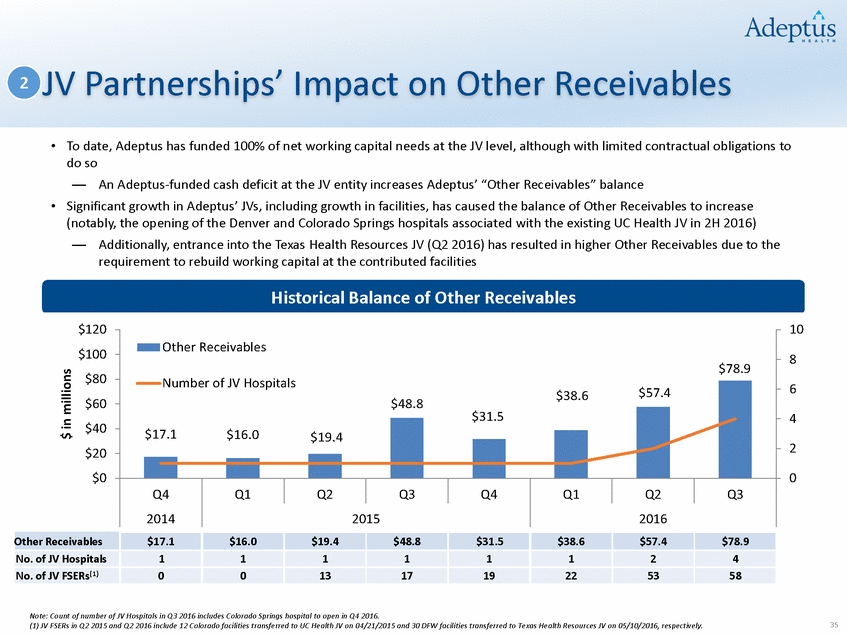
Elevated Pre-Opening Expenses Associated with JV Growth Should Subside 2 Elevated Pre-Opening Expenses Adeptus opened three hospitals in 2H 2016, two of which are contributed to JVs One additional JV hospital is anticipated to come online in Q2 2017 Adeptus is responsible for the labor, marketing and occupancy costs ahead of opening new facilities Solutions Adeptus opened three hospitals in Q3 2016 to move toward a hospital-affiliated HOPD model in more of its markets — ~79% of FSERs are HOPD as of November 1, compared to ~40% at the beginning of Q3 — ~83% of all facilities are expected to be HOPD by year end Going forward, pre-opening expenses will decline, with only one additional hospital opening (Mesa, AZ) in 2017 New FSER facilities tend to have minimal preopening expenses (average of ~$250,000 per new build) and favorable economics, with a rapid ramp to profitability Adeptus is also actively evaluating cost-cutting opportunities and analyzing planned FSER openings • • • • — New hospitals are associated with significantly higher pre-opening expenses compared to new FSER facilities • • • 36 (in thousands) Q1 2016 Q2 2016 Q3 2016 Total Hospital Preopening Expenses ~$200 ~$1,300 ~$12,000 FSERs (21 opened in YTD 2016) ~1,700 ~2,000 ~2,000 Total Preopening Expenses $1,941 $3,294 $14,056
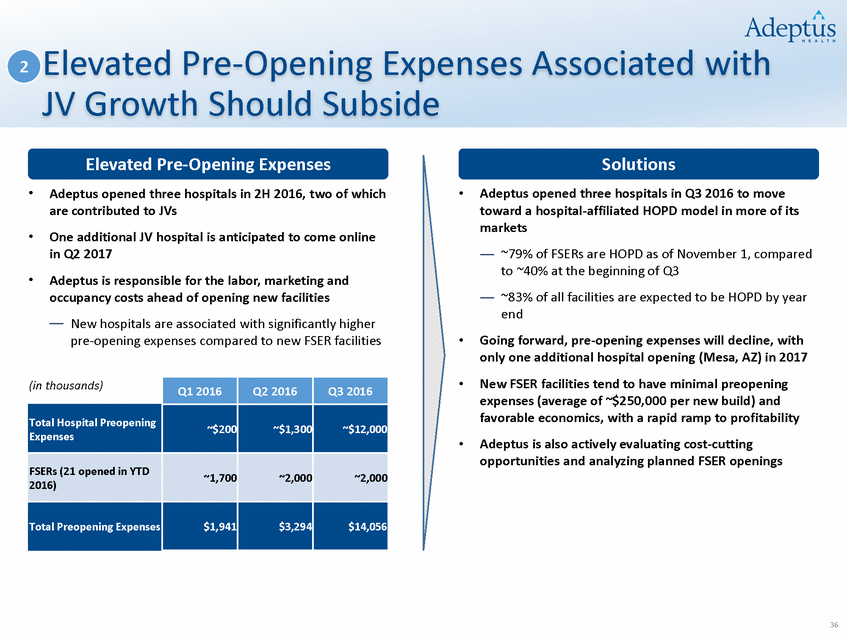
Q3 Financial Performance 3 Performance Q3 is generally the weakest quarter for providers Solutions The healthcare services industry is seeing a continuing shift of volumes from inpatient to outpatient settings • • — Patient volumes are sensitive to seasonal fluctuations in emergency activity — Adeptus is well-positioned to take advantage of this industry shift Adeptus improves access to care by efficiently bringing high-quality care to local communities — — Across the industry, hospitals and healthcare services providers have faced softer volumes and a number of tailwinds to Q3 performance • Since quarter end, Houston and Denver hospital openings have become HOPD markets. The Colorado Springs sites are expected to be converted to HOPDs by the end of the year Same-Store HOPD Patient Volume • Non-HOPD markets, which cannot accept government reimbursement, represented most of the Q3 decline Same-Store Non-HOPD Patient Volume San Antonio Austin Colorado Springs Denver Houston 2,191 3,124 3,175 5,331 16,142 1,358 2,201 4,259 4,641 11,784 -38.0% -29.5% 34.1% -12.9% -27.0% DFW Arizona Colorado Springs Denver Houston 16,085 6,953 25,052 7,034 55.7% 1.2% Expected to become HOPD in Q4 2016 Converted to HOPD Sept. 20, 2016 Converted to HOPD Oct. 11, 2016 Non-HOPD Total 29,963 24,243 -19.1% HOPD Total 23,038 32,086 39.3% Note: Same –Store Patient Volume analysis only includes facilities at least 16 months into opening. In Q3 2016, the same-store count included 66 facilities, of which 24 are HOPD and 42 are non-HOPD. 37 By year end, ~83% of Adeptus’ facilities are expected to be HOPD and therefore able to accept government pay patients Q3 2015Q3 2016% Q3 2015Q3 2016%
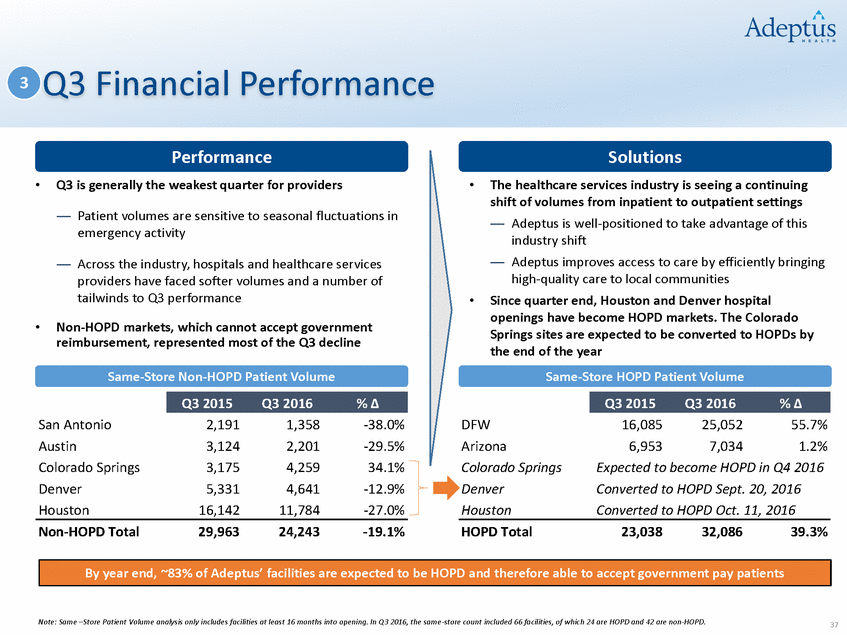
October 2016 Performance Update 3 • • Preliminary October 2016 results already reflect volume uplift relative to Q3 2016 financial results Conversion to HOPD represents a key top-line growth driver, as demonstrated by October volumes, even in markets that only transitioned to HOPD in the past two months —Denver only became a HOPD market on September 20, while Houston converted to HOPD on October 11 With the anticipated conversion of the Colorado Springs market to HOPD by year-end (upon the receipt of certification), ~83% of Adeptus’ facilities are expected to be HOPD • FSER Patient Volumes 38 MarketOct. 2016Q3 2016 Oct. 2016 as a % of Q3 2016 HOPD Conversion Date DFW14,41537,008 39.0% Oct. 2015 Arizona9,22025,333 36.4% Oct. 2014 Houston7,35415,222 48.3% Oct. 2016 Denver4,63210,182 45.5% Sep. 2016 New Orleans793-NA Oct. 2016 Total – HOPD Markets36,41487,745 41.5% Colorado Springs1,4184,230 33.5% Q4 2016 Anticipated Austin9052,644 34.2% NA San Antonio8982,578 34.8% NA Total – Non HOPD Markets3,2219,452 34.1%

Operational Challenges and Adeptus’ Response 1 ~$103mm Use of Cash in LTM 9/30/2016 2 3 39 Q3 Underperformance • Softer Q3 performance was not unique to Adeptus • Non-HOPD markets drove most of the Q3 year-over-year declines, but by year end more than 80% of Adeptus’ facilities are expected to be HOPD • Positive October volume data, particularly in newly HOPD markets JV Working Capital ~$54mm Use of Cash in LTM 9/30/2016 • Adeptus is working with JV partners to share the burden of increased working capital • Q3 represented a peak for pre-opening expenses • The new partner services model going forward is less capital-intensive Revenue Cycle Management • Combination of growth in the business as well as receivables management has caused systemwide DSOs to increase from 54 days in Q3 2015 to 102 days in Q3 2016 • Third-party specialists engaged to address underpayment • Adeptus has a history of collecting nearly all of its net revenue

Financial Overview 40
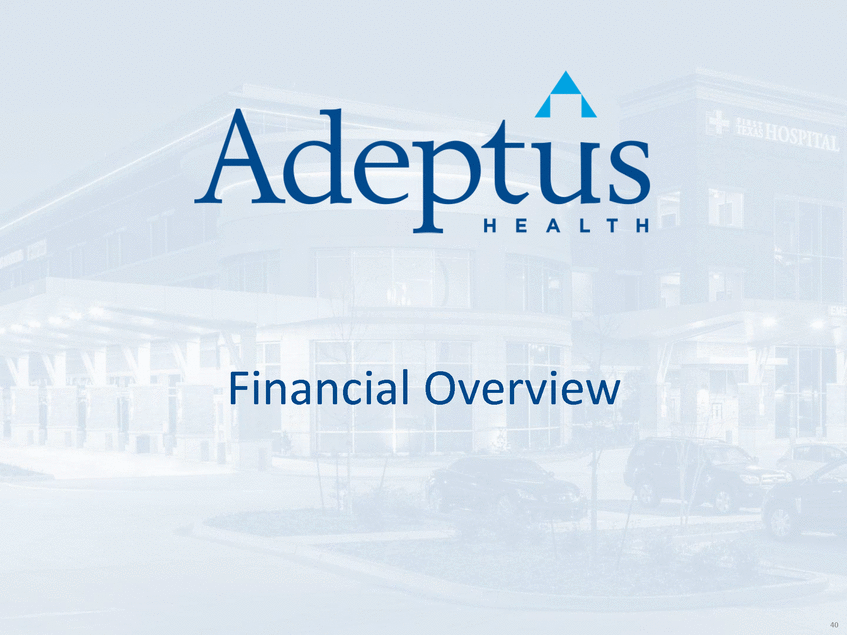
Current Capitalization Pro Forma Capitalization Liquidity Analysis Note: Totals may not sum due to rounding. (1) Balances as of October 27, 2016. (2) $70mm Revolver with $15mm sublimit for LCs, and $5mm sublimit for swingline. Revolver balance shown does not account for $10.1mm of outstanding LCs. (3) Total Leverage calculated as the ratio of (a) Total Debt to (b) Adj. EBITDA. Rent Adjusted Leverage calculated as the ratio of (a) Total Debt plus six times Rent and Lease Expense to (b) Adj. EBITDAR. (4) $27.5m of adjustment reflects Preferred Equity raised from a consortium including Sterling Partners, the Company founders and the CEO. (5) $70mm Revolver Availability reduced by $10.1mm of outstanding LCs and current $59.9mm draw. 41 ($ in millions) Amount 9/30/2016 Adj. (+ / -) Pro Forma Cash and Equivalents $7 $28 $34 (+) Revolver Availability5 - (+) RCF/TLA Accordion - 30 0 30 Total Liquidity $7 $64 ($ in millions) Amount 9/30/2016 Leverage Adj. (+ / -) Pro Forma Leverage Cash and Equivalents1 $7 $28 $ 34 Revolver ($70)1,2 60 60 RCF / TLA Accordion ($30) - - Term Loan A2119 119 Capital Leases 0 0 Total Debt3$1792.4 x $1792.4 x 6.0x Rent and Lease Expense 133 133 Rent Adj. Debt3$3123.2 x $3123.2 x Preferred Equity 28 28 LTM Reported Adjusted EBITDA $75 $75 LTM Adjusted EBITDAR $97 $97
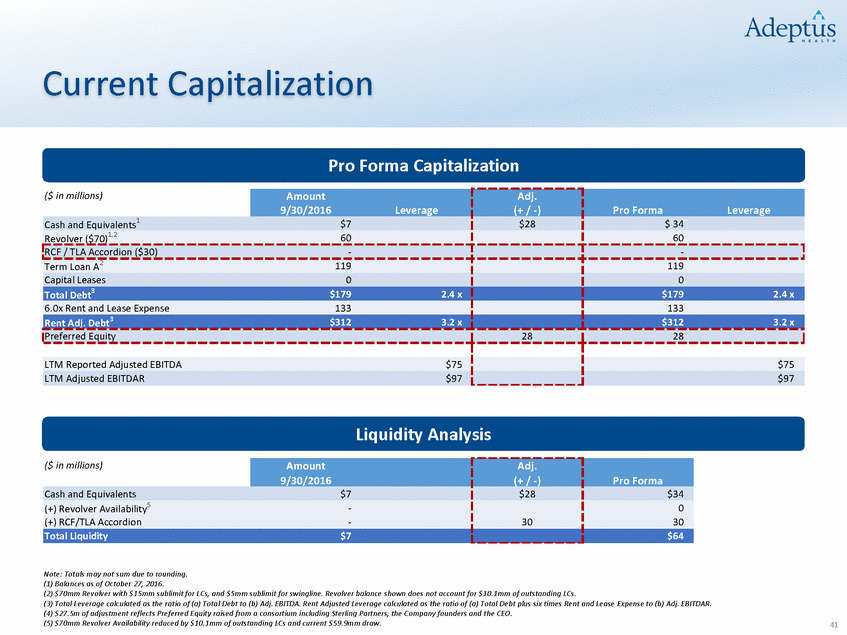
Systemwide Revenue Annual Systemwide Net Patient Services Revenue Quarterly Systemwide Net Patient Services Revenue (in $ millions) (in $ millions) $553.9 + 84% Unconsolidated Joint Ventures Unconsolidated $143.4 $142.4 $140.4 Facilities $0.2 Q2-15 Q3-15 Q4-15 Q1-16 Q2-16 Q3-16 2013A 2014A 2015A LTM YoY Growth Note: Totals may not sum due to rounding. Systemwide net patient services revenue treats unconsolidated facilities as if they were consolidated. 42 +136.2% +89.3% +81.7% +67.2% +36.3% +31.5% $57.5 $81.6 Consolidated$127.8 $34.1 $104.5$109.0 $28.4 $25.7 $106.2 $17.7 $99.3 $86.8 $84.9 $83.3 $61.8 Joint VenturesCAGR Consolidated Facilities$425.3 $201.6 $210.9 $74.8 $352.3 $350.5 $102.9 $210.7 $102.9
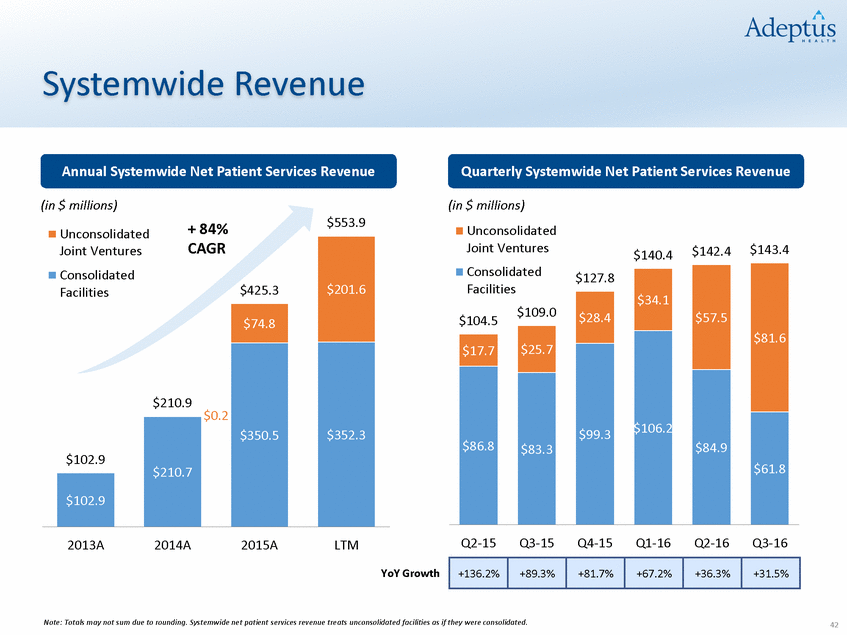
Attractive Payor Mix and In-Network Rates Net Patient Services Revenue by Payor Net Patient Services Revenue Breakdown Medicare / Medicaid 2% Cigna 14% United Healthcare 31% Aetna 15% • Charity care is accounted for within Patient Service Revenue and includes Medicare / Medicaid in non-HOPD markets Other Commercial 19% BCBS 18% • Provision for bad debt primarily consists of the estimated uncollectible amounts from insured patients — Bad debt write-offs represent 12.0% of systemwide patient services revenue, in line with other acute care hospitals Q3 2016 Note: Totals may not sum due to rounding. 43 (in $ millions) Q3 2016 % of Revenue Patient Service Revenue $70.2 – Provision for Bad Debts (8.4) 12.0% Net Patient Service Revenue $61.8 88.0%

Trends in Same-Store Sales and Volume Same-Store Volume Breakdown Same-Store Revenue (23)% YoY Decline $65.0 2014 Non-HOPD 100% Q3 2015 Q3 2016 +18% YoY Growth $40.3 Non-HOPD 43% As of 9/30/2016 HOPD 57% Q3 2015 Q3 2016 Note: Totals may not sum due to rounding. Same –Store analysis only includes facilities at least 16 months into opening. In Q3 2016, the same-store count included 66 facilities, of which 24 are HOPD and 42 are non-HOPD. Same-Store revenues do not include the effect of NMP and management fees. 44 HOPD Non-HOPD As of November 1, ~79% of all facilities were HOPD, which is expected to increase to ~83% by year end $34.0 $50.0 HOPD Markets Show Greater Resiliency than Non-HOPD Markets

Adjusted EBITDA (as Reported) Annual Adjusted EBITDA(1) Quarterly Adjusted EBITDA(1) (in $ millions) (in $ millions) $22.9 $75.9 $75.0 $22.5 $21.7 $21.1 $28.2 2014A 2015A 2016E Q1-15 Q2-15 Q3-15 Q4-15 Q1-16 Q2-16 Q3-16 Q4-16E Note: Totals may not sum due to rounding. (1) 2016E Annual Adjusted EBITDA reflects midpoint of management guidance of $70mm to $80mm and Q4 2016E shows implied EBITDA. 45 $13.3 $21.1 $9.7 $18.6
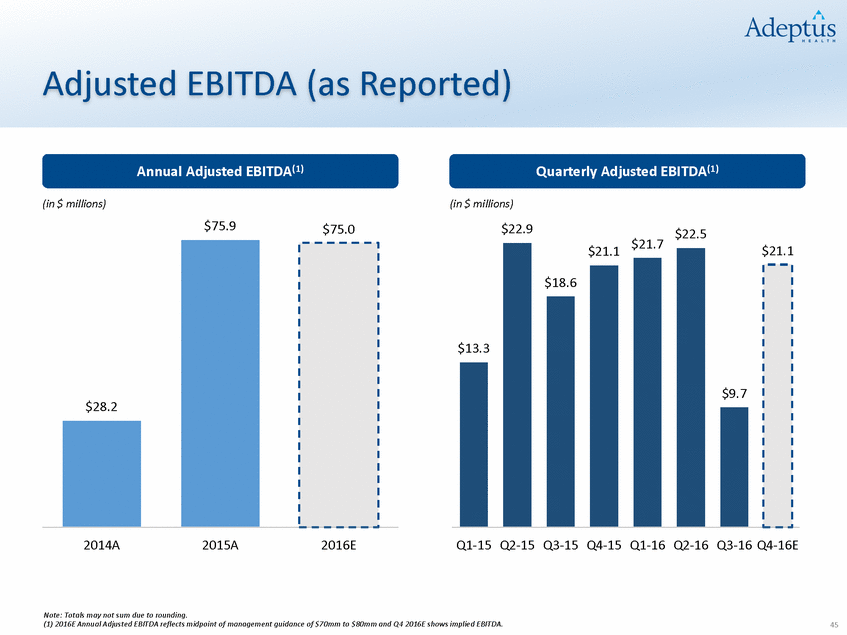
Appendix 46
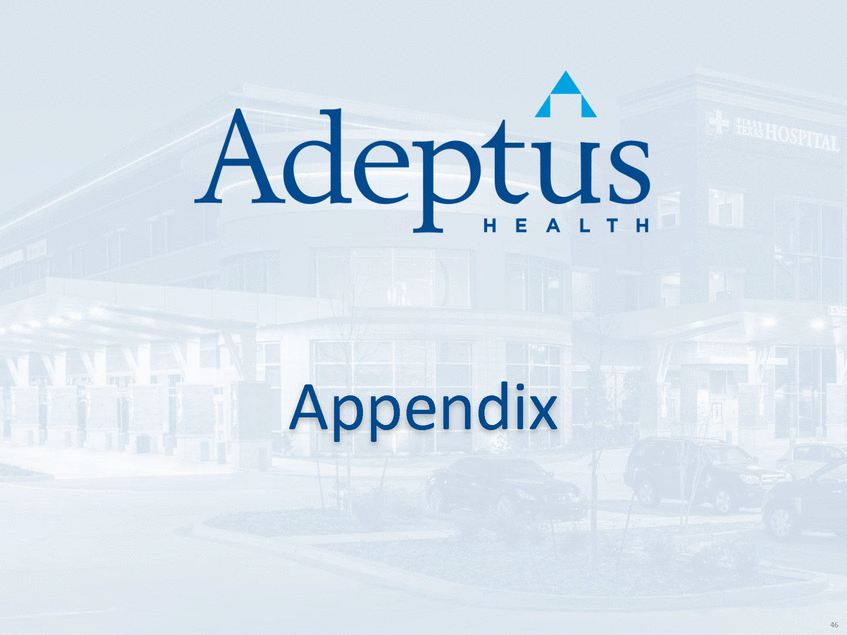
Sources of Earnings to Adeptus company-owned facilities management fee NMP management services Distribution (typically 49% / 51%) (1) Preferential Earnings Distribution applies to the UC Health JV in Colorado and the Texas Health Resources JV in Dallas Fort Worth. 47 Description Financial Impact Adeptus’ Earnings from Consolidated Facilities 100% of Net Revenues Margin on revenues earned at Adeptus’ Earnings from Unconsolidated JVs Management Fee Percentage of Net Revenues paid by JV entities Margin on revenues associated with National Medical Professionals (NMP) Fee Markup on physician staffing services provided, at a rate consistent with market Margin on revenues associated with (1) Preferential Earnings Distribution 100% of net earnings or losses up to Preferential Earnings Distribution (in certain markets) 100% of Preferred Earnings Residual JV Earnings Residual earnings after Preferred Distribution split based on JV ownership % Adeptus split of residual earnings
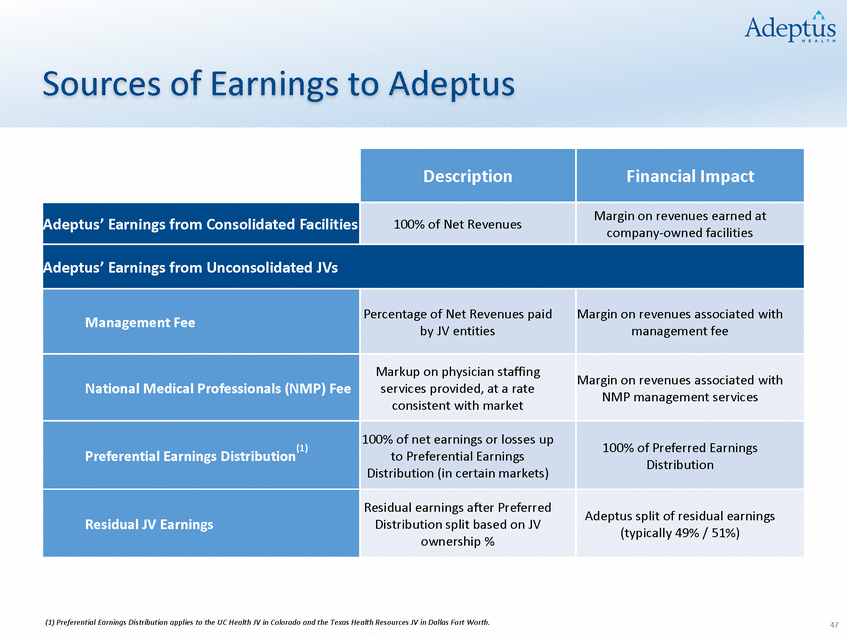
Corporate Organizational Structure Delaware Corp. Texas LLC Texas LLC with Ochsner Health) 48 Existing Guarantor Adeptus Health Inc. Joint Venture Direct Subsidiary Indirect Subsidiary Adeptus Health LLC Delaware LLC First Choice ER, LLC Texas LLC (Borrower) $219mm Senior Secured Credit Facilities Adeptus Health Management LLC Texas LLC Adeptus Health Ventures LLC Texas LLC FCER Management, LLC Texas LLC ECC Management, LLC Texas LLC OpFree, LLC 100% Owned Freestanding Emergency Room Facilities ADPT New Orleans Management, LLC (Party to Partner Services Agreement Arizona JV: AGH Phoenix LLC Arizona LLC (JV with Dignity Health) (49.9%) Ohio JV: Mount Carmel EHN, LLC Ohio LLC (JV with Carmel Health) (50.1%) DFW JV: FTH DFW Partners LLC Texas LLC (JV with Texas Health Resources) (49.0%) Colorado JV: UCHealth Partners LLC Colorado LLC (JV with University of Colorado Health) (49.9%) National Medical Professionals of Ohio LLC Ohio LLC National Medical Professionals of Arizona LLC Arizona LLC
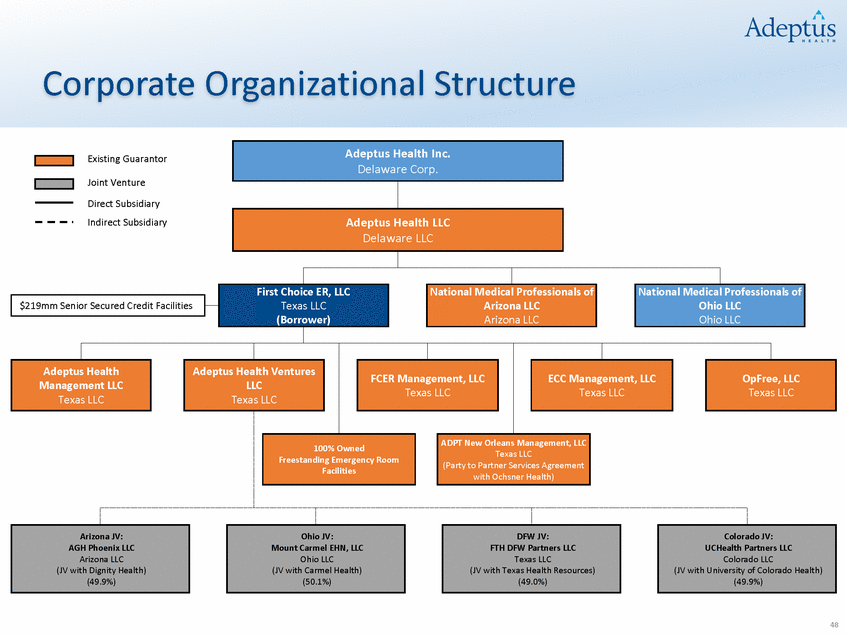
Preferred Stock Term Sheet dissolution or winding up of the Company, the payment of dividends and rights of redemption Company report LTM Adjusted EBITDA of $125 million or more for two consecutive quarters 49 Issuer • Adeptus Health Inc. Amount • $27.5 million Rank • Senior to the Company’s common stock with respect to the distribution of assets on the liquidation, Dividends • Accrues daily at the rate of 8.0% per annum — To the extent such dividends are not declared and paid, such dividends will accumulate OID • None Liquidation Preference • Upon a Deemed Liquidation Event, holders will receive the following “Liquidation Value”: — Par plus accumulated and unpaid dividends Optional Redemption • Year 1: 104% of Liquidation Value • Year 2: 102% of Liquidation Value • Years 3 – 10: Liquidation Value Voting Governance Rights • Non-voting Covenants • Majority approval required for issuances of senior equity securities • Majority approval required for the incurrence of new indebtedness in excess of $400 million Other • Company agrees to use commercially reasonable efforts to refinance the Preferred Stock should the
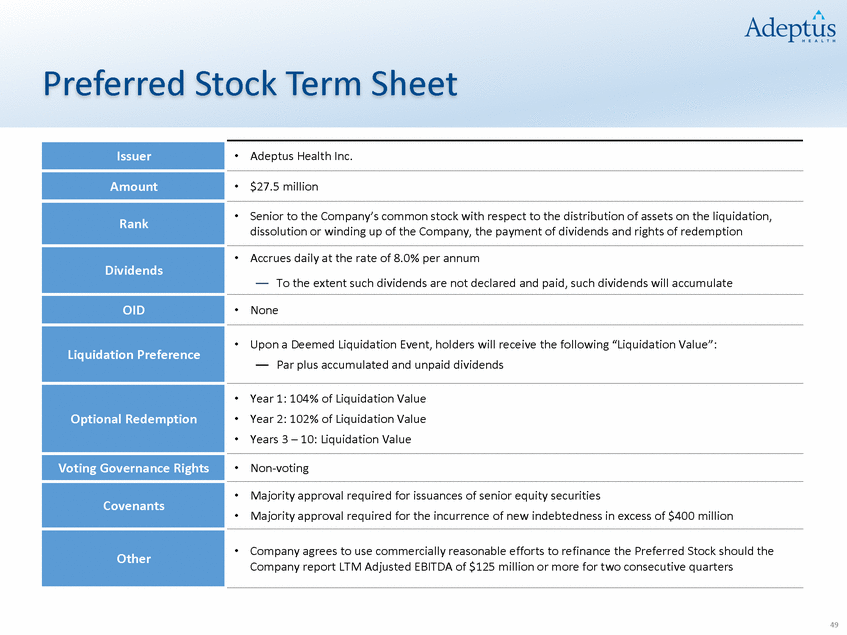
EBITDA Reconciliation Commentary Consists of a gain recognized on the contribution and change of control of previously owned freestanding facilities to the joint venture with University of Colorado Health and Texas Health Resources. Includes labor, marketing costs and occupancy costs prior to opening facilities and hospital losses prior to obtaining Medicare certification. Stock compensation expense associated with grants of management incentive units and stock options. Consists of costs incurred in conjunction with our initial and secondary public offerings, including bonuses for certain members of management, costs related to the termination of our Advisory Services Agreement, and other offering costs. Consists of duplicative costs, including salaries, stay bonuses and contract labor costs, incurred during the transition to outsourced billing services for the ICD-10 conversion. Consists of losses incurred on the extinguishment of the prior Credit Facility. Includes costs to develop long-term strategic goals and objectives, real-estate development costs, fees involved in recruiting our management team, and management fees. (Aa) (Bb) A (Cc) B C D E F G (Dd) (Ee) (fF) (Gg) 50 Note: Totals may not sum due to rounding. (in $ millions) Year Ended December 31, LTM 9/30/2016 2014 2015 Net Income (Loss)$(17.3)$32.8$146.4 Depreciation & Amortization15.019.320.4 Interest Expense / Other Expenses12.012.87.5 (Benefit) Provision for Income Taxes(1.3)8.746.7 Gain on Contribution to Joint Venture–(24.3)(185.3) EBITDA$8.4$49.4$35.7 Preopening Expenses10.613.023.1 Stock Compensation Expenses1.02.84.6 Initial Public Offering Costs5.22.10.5 Duplicative billing effort–0.91.1 Loss on extinguishment of debt–5.05.0 Other3.12.75.0 Total Adjustments$19.8$26.5$39.3 Adjusted EBITDA$28.2$75.9$75.0
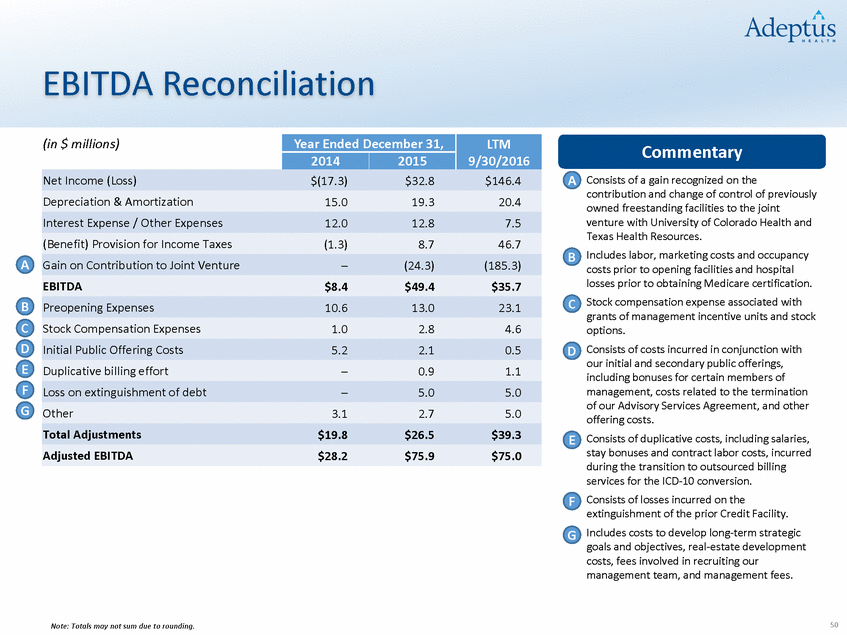
Supplemental non GAAP Disclosures September 31, Systemwide net patient services revenue treats unconsolidated facilities as if they were consolidated. 51 (in $ thousands) Year Ended December 31, 9 Months Ended 2015 2014 2013 2016 2015 Net Patient Services Revenue: Consolidated Facilities$350,493$210,674$102,883 $252,973$251,154 Unconsolidated Joint Ventures74,769247– 173,16846,354 Systemwide Net Patient Services Revenue$425,262$210,921$102,883 $426,141$297,508

